Analysis of International Trade Theories and Their Application to Current International Trade Practices
VerifiedAdded on 2023/06/10
|22
|6831
|89
AI Summary
This report analyses International Trade Theories and Their Application to Current International Trade Practices with a focus on Japan and Switzerland. It covers trade structure, absolute and comparative advantage, factor endowment trade, income distribution, and new trade theories.
Contribute Materials
Your contribution can guide someone’s learning journey. Share your
documents today.
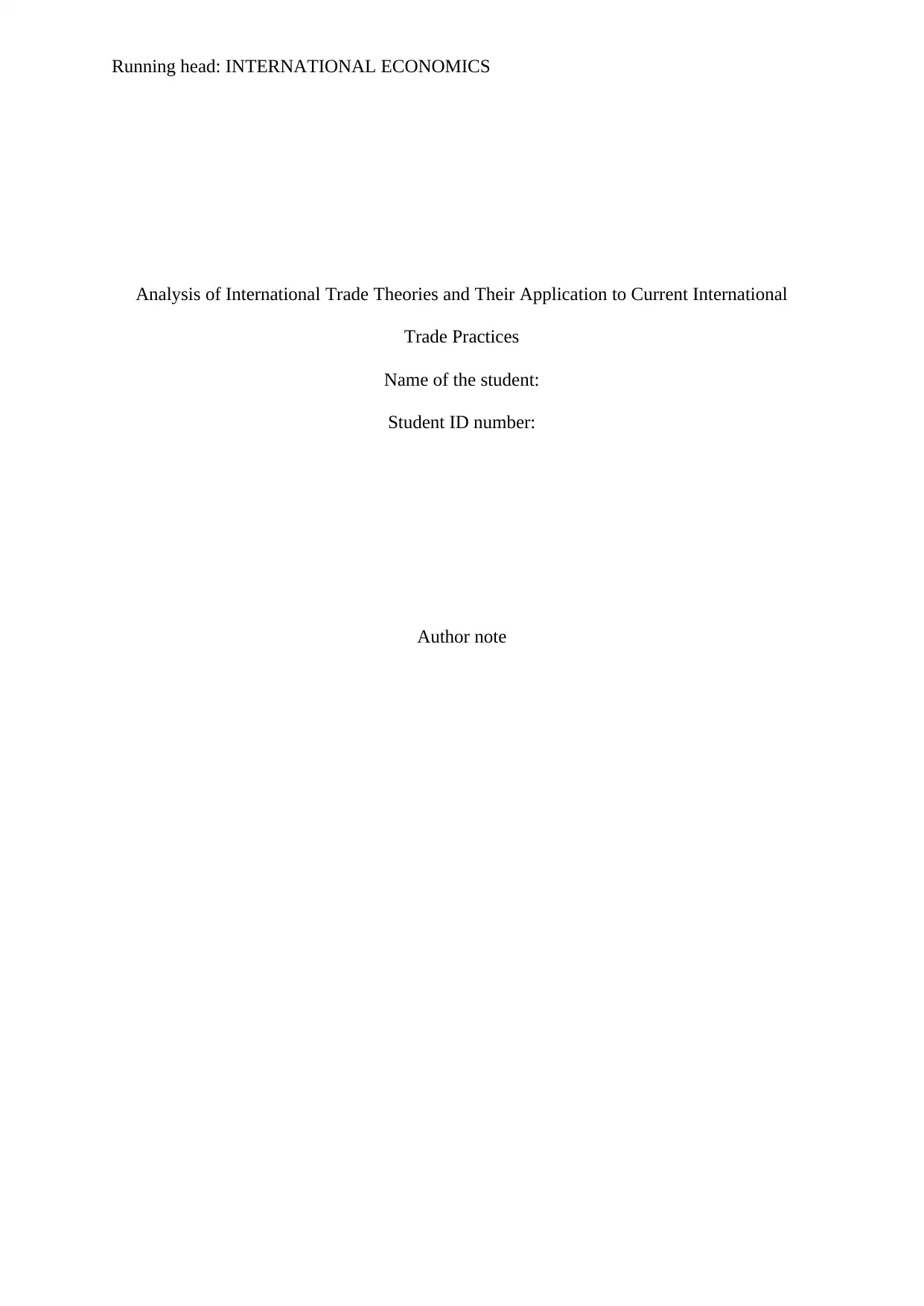
Running head: INTERNATIONAL ECONOMICS
Analysis of International Trade Theories and Their Application to Current International
Trade Practices
Name of the student:
Student ID number:
Author note
Analysis of International Trade Theories and Their Application to Current International
Trade Practices
Name of the student:
Student ID number:
Author note
Secure Best Marks with AI Grader
Need help grading? Try our AI Grader for instant feedback on your assignments.
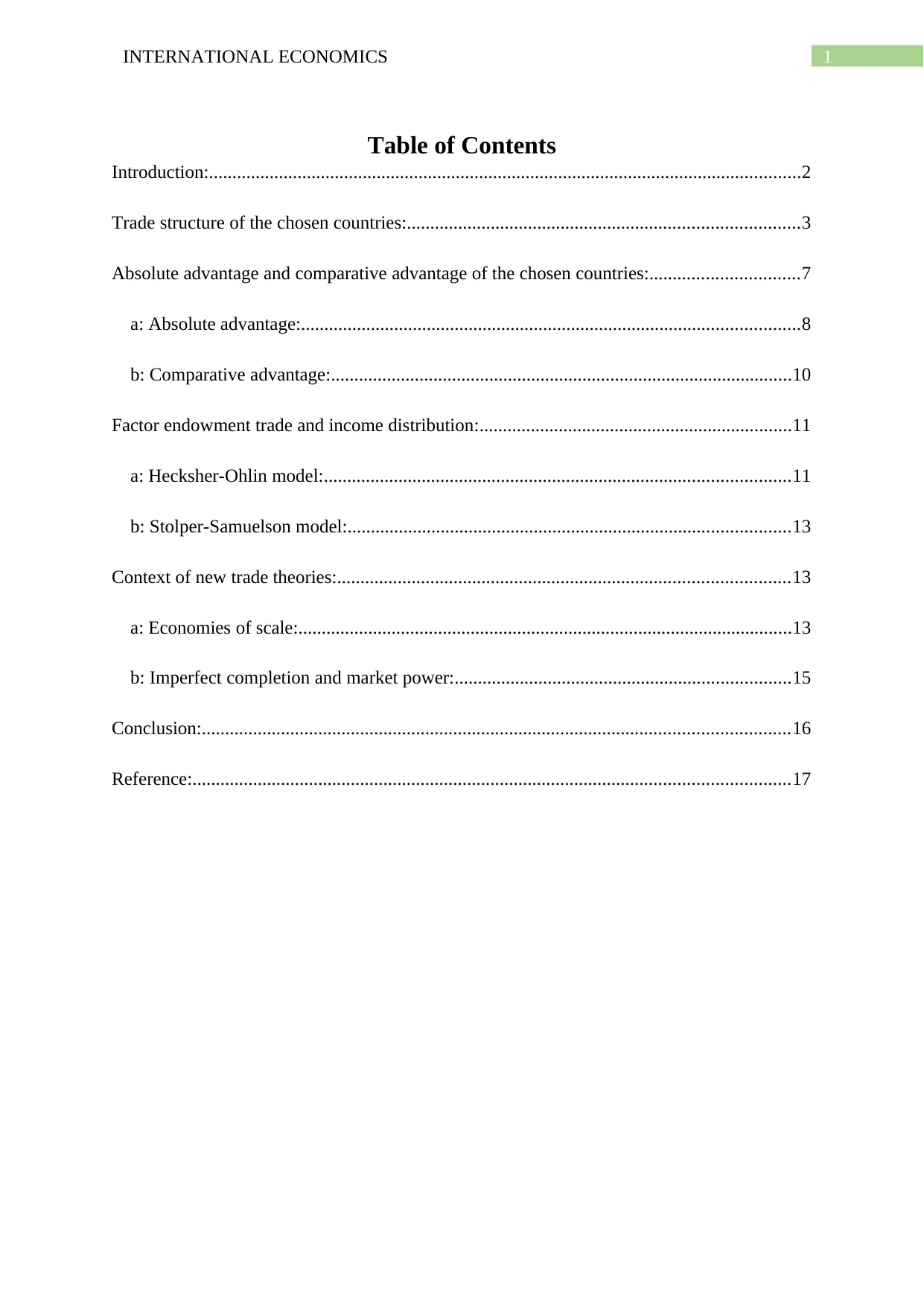
1INTERNATIONAL ECONOMICS
Table of Contents
Introduction:...............................................................................................................................2
Trade structure of the chosen countries:....................................................................................3
Absolute advantage and comparative advantage of the chosen countries:................................7
a: Absolute advantage:...........................................................................................................8
b: Comparative advantage:...................................................................................................10
Factor endowment trade and income distribution:...................................................................11
a: Hecksher-Ohlin model:....................................................................................................11
b: Stolper-Samuelson model:...............................................................................................13
Context of new trade theories:.................................................................................................13
a: Economies of scale:..........................................................................................................13
b: Imperfect completion and market power:........................................................................15
Conclusion:..............................................................................................................................16
Reference:................................................................................................................................17
Table of Contents
Introduction:...............................................................................................................................2
Trade structure of the chosen countries:....................................................................................3
Absolute advantage and comparative advantage of the chosen countries:................................7
a: Absolute advantage:...........................................................................................................8
b: Comparative advantage:...................................................................................................10
Factor endowment trade and income distribution:...................................................................11
a: Hecksher-Ohlin model:....................................................................................................11
b: Stolper-Samuelson model:...............................................................................................13
Context of new trade theories:.................................................................................................13
a: Economies of scale:..........................................................................................................13
b: Imperfect completion and market power:........................................................................15
Conclusion:..............................................................................................................................16
Reference:................................................................................................................................17
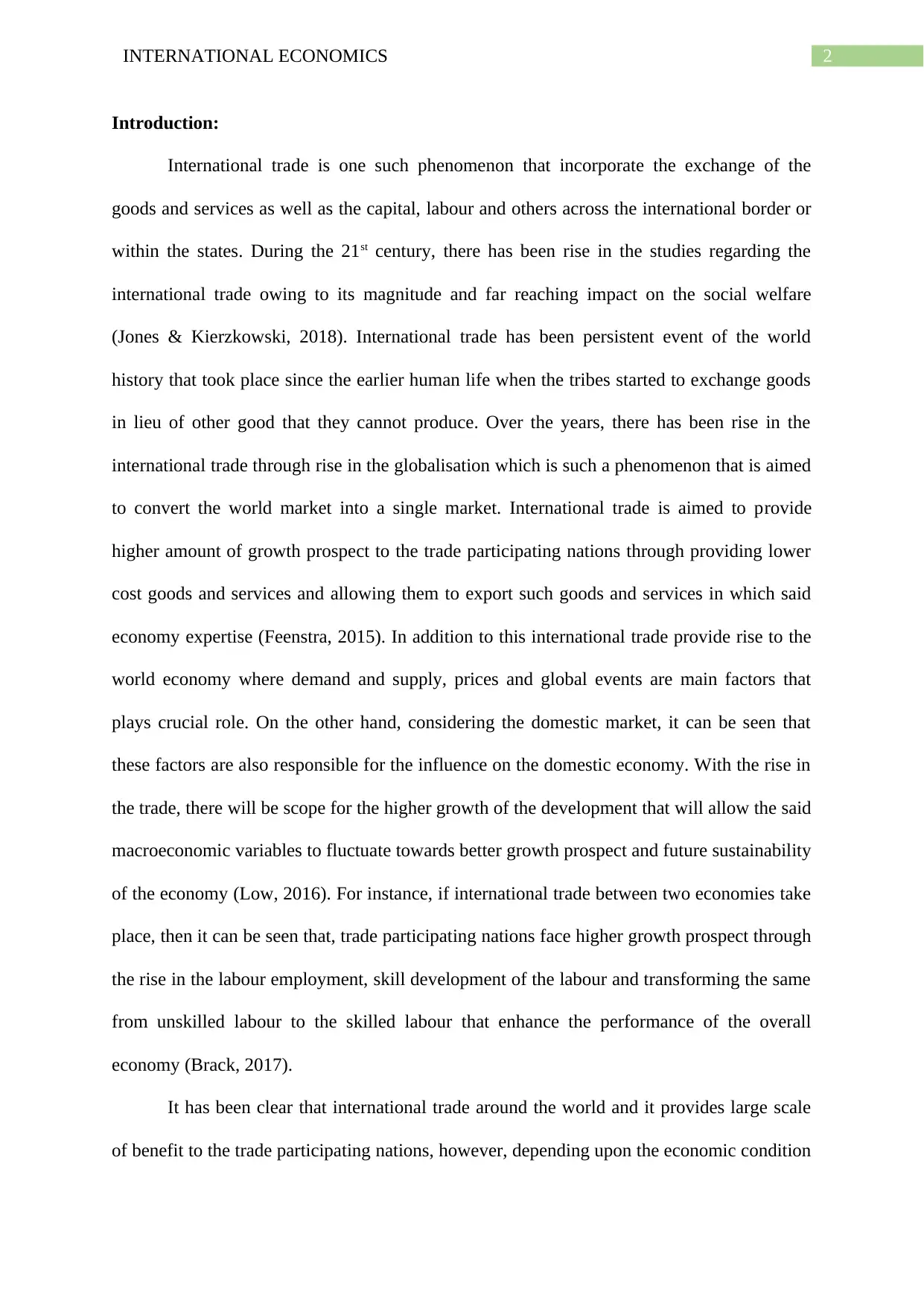
2INTERNATIONAL ECONOMICS
Introduction:
International trade is one such phenomenon that incorporate the exchange of the
goods and services as well as the capital, labour and others across the international border or
within the states. During the 21st century, there has been rise in the studies regarding the
international trade owing to its magnitude and far reaching impact on the social welfare
(Jones & Kierzkowski, 2018). International trade has been persistent event of the world
history that took place since the earlier human life when the tribes started to exchange goods
in lieu of other good that they cannot produce. Over the years, there has been rise in the
international trade through rise in the globalisation which is such a phenomenon that is aimed
to convert the world market into a single market. International trade is aimed to provide
higher amount of growth prospect to the trade participating nations through providing lower
cost goods and services and allowing them to export such goods and services in which said
economy expertise (Feenstra, 2015). In addition to this international trade provide rise to the
world economy where demand and supply, prices and global events are main factors that
plays crucial role. On the other hand, considering the domestic market, it can be seen that
these factors are also responsible for the influence on the domestic economy. With the rise in
the trade, there will be scope for the higher growth of the development that will allow the said
macroeconomic variables to fluctuate towards better growth prospect and future sustainability
of the economy (Low, 2016). For instance, if international trade between two economies take
place, then it can be seen that, trade participating nations face higher growth prospect through
the rise in the labour employment, skill development of the labour and transforming the same
from unskilled labour to the skilled labour that enhance the performance of the overall
economy (Brack, 2017).
It has been clear that international trade around the world and it provides large scale
of benefit to the trade participating nations, however, depending upon the economic condition
Introduction:
International trade is one such phenomenon that incorporate the exchange of the
goods and services as well as the capital, labour and others across the international border or
within the states. During the 21st century, there has been rise in the studies regarding the
international trade owing to its magnitude and far reaching impact on the social welfare
(Jones & Kierzkowski, 2018). International trade has been persistent event of the world
history that took place since the earlier human life when the tribes started to exchange goods
in lieu of other good that they cannot produce. Over the years, there has been rise in the
international trade through rise in the globalisation which is such a phenomenon that is aimed
to convert the world market into a single market. International trade is aimed to provide
higher amount of growth prospect to the trade participating nations through providing lower
cost goods and services and allowing them to export such goods and services in which said
economy expertise (Feenstra, 2015). In addition to this international trade provide rise to the
world economy where demand and supply, prices and global events are main factors that
plays crucial role. On the other hand, considering the domestic market, it can be seen that
these factors are also responsible for the influence on the domestic economy. With the rise in
the trade, there will be scope for the higher growth of the development that will allow the said
macroeconomic variables to fluctuate towards better growth prospect and future sustainability
of the economy (Low, 2016). For instance, if international trade between two economies take
place, then it can be seen that, trade participating nations face higher growth prospect through
the rise in the labour employment, skill development of the labour and transforming the same
from unskilled labour to the skilled labour that enhance the performance of the overall
economy (Brack, 2017).
It has been clear that international trade around the world and it provides large scale
of benefit to the trade participating nations, however, depending upon the economic condition
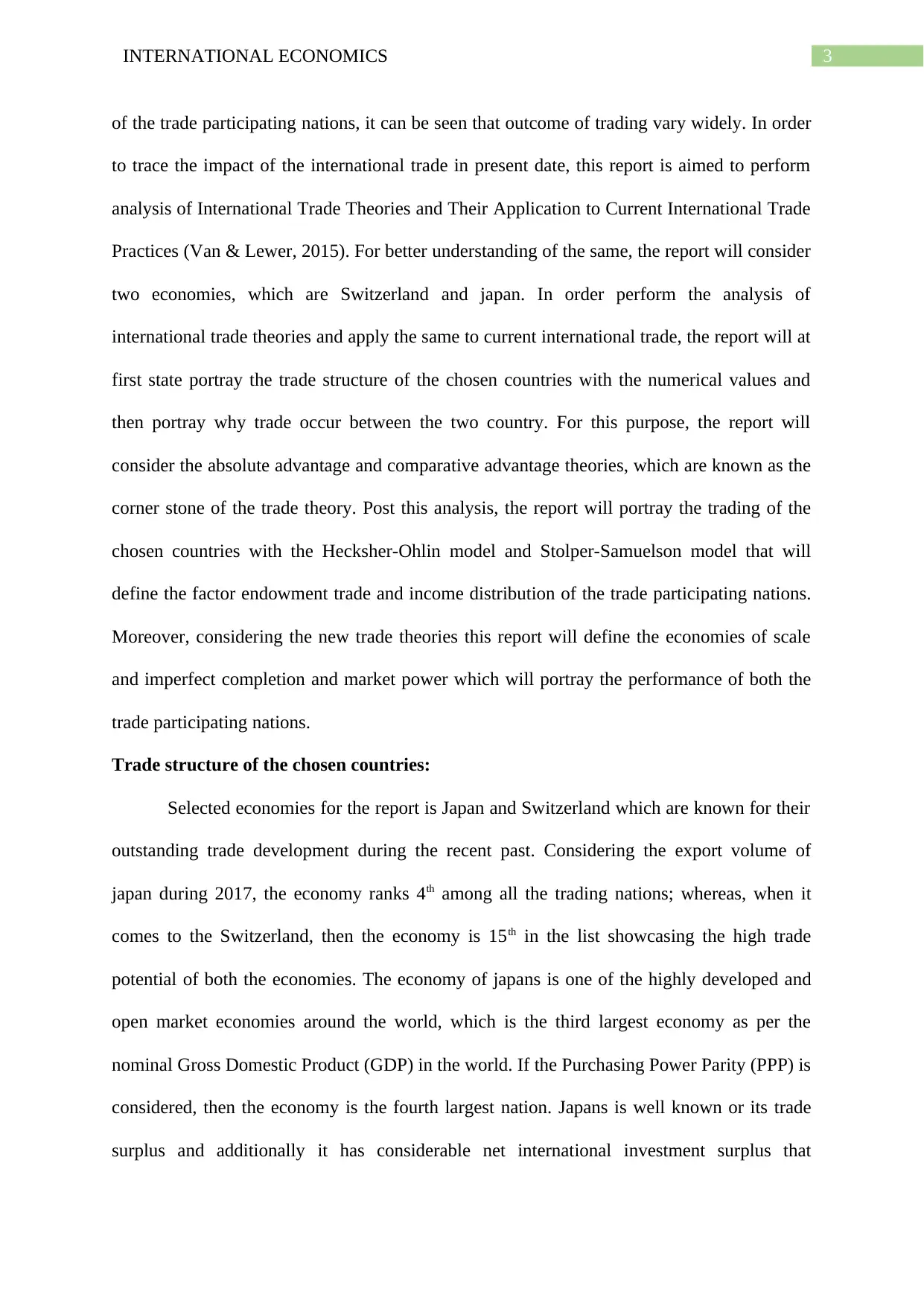
3INTERNATIONAL ECONOMICS
of the trade participating nations, it can be seen that outcome of trading vary widely. In order
to trace the impact of the international trade in present date, this report is aimed to perform
analysis of International Trade Theories and Their Application to Current International Trade
Practices (Van & Lewer, 2015). For better understanding of the same, the report will consider
two economies, which are Switzerland and japan. In order perform the analysis of
international trade theories and apply the same to current international trade, the report will at
first state portray the trade structure of the chosen countries with the numerical values and
then portray why trade occur between the two country. For this purpose, the report will
consider the absolute advantage and comparative advantage theories, which are known as the
corner stone of the trade theory. Post this analysis, the report will portray the trading of the
chosen countries with the Hecksher-Ohlin model and Stolper-Samuelson model that will
define the factor endowment trade and income distribution of the trade participating nations.
Moreover, considering the new trade theories this report will define the economies of scale
and imperfect completion and market power which will portray the performance of both the
trade participating nations.
Trade structure of the chosen countries:
Selected economies for the report is Japan and Switzerland which are known for their
outstanding trade development during the recent past. Considering the export volume of
japan during 2017, the economy ranks 4th among all the trading nations; whereas, when it
comes to the Switzerland, then the economy is 15th in the list showcasing the high trade
potential of both the economies. The economy of japans is one of the highly developed and
open market economies around the world, which is the third largest economy as per the
nominal Gross Domestic Product (GDP) in the world. If the Purchasing Power Parity (PPP) is
considered, then the economy is the fourth largest nation. Japans is well known or its trade
surplus and additionally it has considerable net international investment surplus that
of the trade participating nations, it can be seen that outcome of trading vary widely. In order
to trace the impact of the international trade in present date, this report is aimed to perform
analysis of International Trade Theories and Their Application to Current International Trade
Practices (Van & Lewer, 2015). For better understanding of the same, the report will consider
two economies, which are Switzerland and japan. In order perform the analysis of
international trade theories and apply the same to current international trade, the report will at
first state portray the trade structure of the chosen countries with the numerical values and
then portray why trade occur between the two country. For this purpose, the report will
consider the absolute advantage and comparative advantage theories, which are known as the
corner stone of the trade theory. Post this analysis, the report will portray the trading of the
chosen countries with the Hecksher-Ohlin model and Stolper-Samuelson model that will
define the factor endowment trade and income distribution of the trade participating nations.
Moreover, considering the new trade theories this report will define the economies of scale
and imperfect completion and market power which will portray the performance of both the
trade participating nations.
Trade structure of the chosen countries:
Selected economies for the report is Japan and Switzerland which are known for their
outstanding trade development during the recent past. Considering the export volume of
japan during 2017, the economy ranks 4th among all the trading nations; whereas, when it
comes to the Switzerland, then the economy is 15th in the list showcasing the high trade
potential of both the economies. The economy of japans is one of the highly developed and
open market economies around the world, which is the third largest economy as per the
nominal Gross Domestic Product (GDP) in the world. If the Purchasing Power Parity (PPP) is
considered, then the economy is the fourth largest nation. Japans is well known or its trade
surplus and additionally it has considerable net international investment surplus that
Secure Best Marks with AI Grader
Need help grading? Try our AI Grader for instant feedback on your assignments.
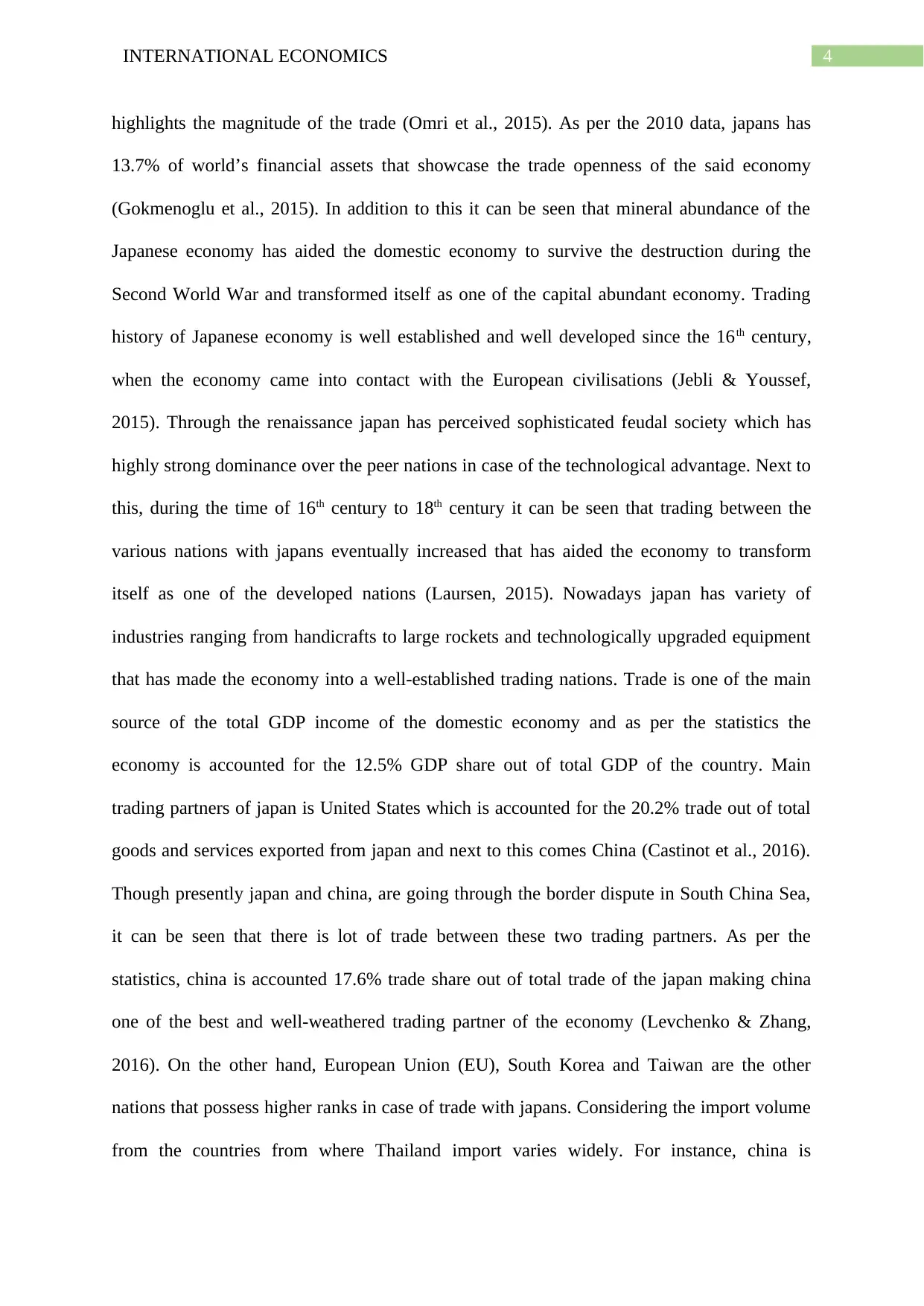
4INTERNATIONAL ECONOMICS
highlights the magnitude of the trade (Omri et al., 2015). As per the 2010 data, japans has
13.7% of world’s financial assets that showcase the trade openness of the said economy
(Gokmenoglu et al., 2015). In addition to this it can be seen that mineral abundance of the
Japanese economy has aided the domestic economy to survive the destruction during the
Second World War and transformed itself as one of the capital abundant economy. Trading
history of Japanese economy is well established and well developed since the 16th century,
when the economy came into contact with the European civilisations (Jebli & Youssef,
2015). Through the renaissance japan has perceived sophisticated feudal society which has
highly strong dominance over the peer nations in case of the technological advantage. Next to
this, during the time of 16th century to 18th century it can be seen that trading between the
various nations with japans eventually increased that has aided the economy to transform
itself as one of the developed nations (Laursen, 2015). Nowadays japan has variety of
industries ranging from handicrafts to large rockets and technologically upgraded equipment
that has made the economy into a well-established trading nations. Trade is one of the main
source of the total GDP income of the domestic economy and as per the statistics the
economy is accounted for the 12.5% GDP share out of total GDP of the country. Main
trading partners of japan is United States which is accounted for the 20.2% trade out of total
goods and services exported from japan and next to this comes China (Castinot et al., 2016).
Though presently japan and china, are going through the border dispute in South China Sea,
it can be seen that there is lot of trade between these two trading partners. As per the
statistics, china is accounted 17.6% trade share out of total trade of the japan making china
one of the best and well-weathered trading partner of the economy (Levchenko & Zhang,
2016). On the other hand, European Union (EU), South Korea and Taiwan are the other
nations that possess higher ranks in case of trade with japans. Considering the import volume
from the countries from where Thailand import varies widely. For instance, china is
highlights the magnitude of the trade (Omri et al., 2015). As per the 2010 data, japans has
13.7% of world’s financial assets that showcase the trade openness of the said economy
(Gokmenoglu et al., 2015). In addition to this it can be seen that mineral abundance of the
Japanese economy has aided the domestic economy to survive the destruction during the
Second World War and transformed itself as one of the capital abundant economy. Trading
history of Japanese economy is well established and well developed since the 16th century,
when the economy came into contact with the European civilisations (Jebli & Youssef,
2015). Through the renaissance japan has perceived sophisticated feudal society which has
highly strong dominance over the peer nations in case of the technological advantage. Next to
this, during the time of 16th century to 18th century it can be seen that trading between the
various nations with japans eventually increased that has aided the economy to transform
itself as one of the developed nations (Laursen, 2015). Nowadays japan has variety of
industries ranging from handicrafts to large rockets and technologically upgraded equipment
that has made the economy into a well-established trading nations. Trade is one of the main
source of the total GDP income of the domestic economy and as per the statistics the
economy is accounted for the 12.5% GDP share out of total GDP of the country. Main
trading partners of japan is United States which is accounted for the 20.2% trade out of total
goods and services exported from japan and next to this comes China (Castinot et al., 2016).
Though presently japan and china, are going through the border dispute in South China Sea,
it can be seen that there is lot of trade between these two trading partners. As per the
statistics, china is accounted 17.6% trade share out of total trade of the japan making china
one of the best and well-weathered trading partner of the economy (Levchenko & Zhang,
2016). On the other hand, European Union (EU), South Korea and Taiwan are the other
nations that possess higher ranks in case of trade with japans. Considering the import volume
from the countries from where Thailand import varies widely. For instance, china is
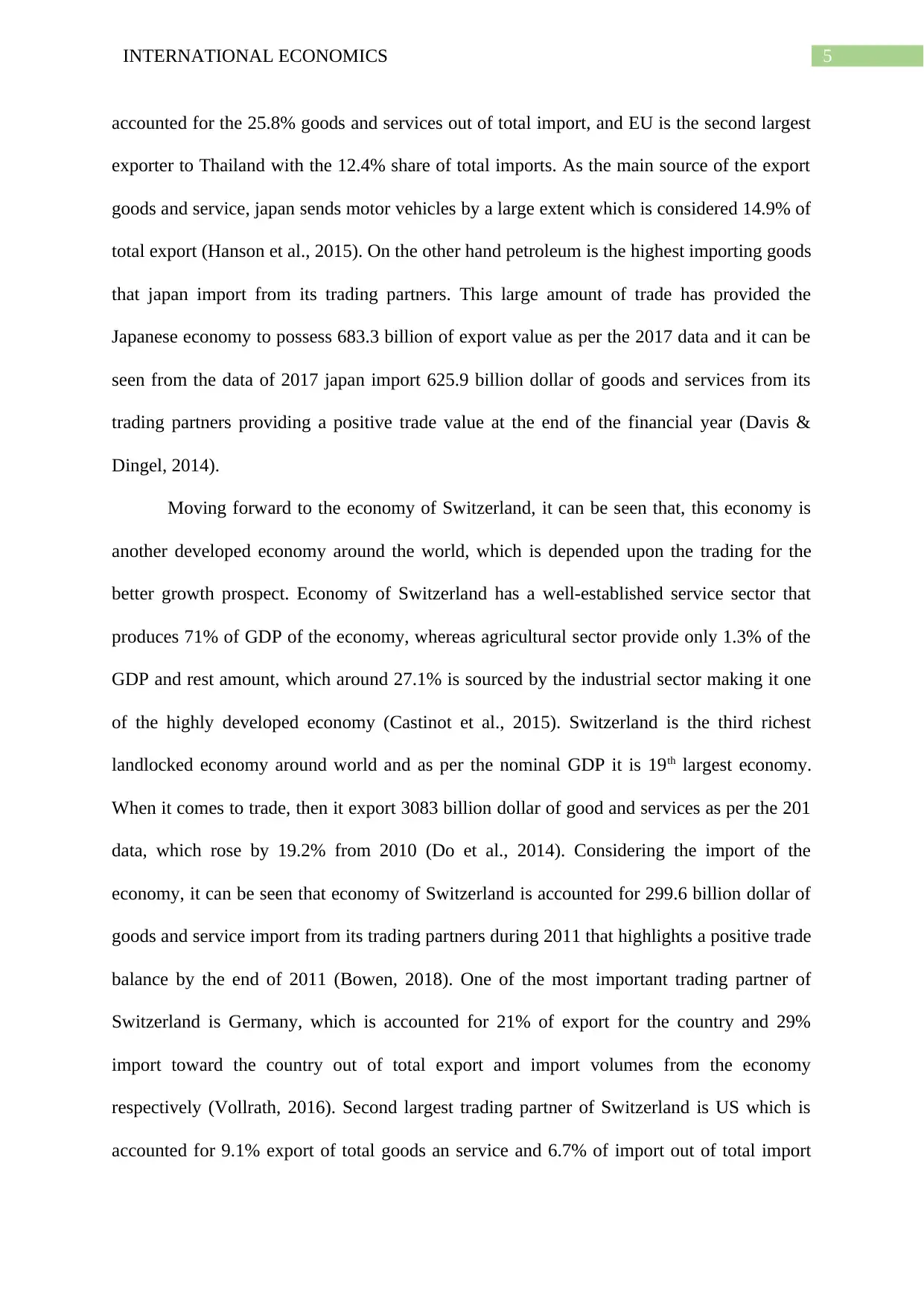
5INTERNATIONAL ECONOMICS
accounted for the 25.8% goods and services out of total import, and EU is the second largest
exporter to Thailand with the 12.4% share of total imports. As the main source of the export
goods and service, japan sends motor vehicles by a large extent which is considered 14.9% of
total export (Hanson et al., 2015). On the other hand petroleum is the highest importing goods
that japan import from its trading partners. This large amount of trade has provided the
Japanese economy to possess 683.3 billion of export value as per the 2017 data and it can be
seen from the data of 2017 japan import 625.9 billion dollar of goods and services from its
trading partners providing a positive trade value at the end of the financial year (Davis &
Dingel, 2014).
Moving forward to the economy of Switzerland, it can be seen that, this economy is
another developed economy around the world, which is depended upon the trading for the
better growth prospect. Economy of Switzerland has a well-established service sector that
produces 71% of GDP of the economy, whereas agricultural sector provide only 1.3% of the
GDP and rest amount, which around 27.1% is sourced by the industrial sector making it one
of the highly developed economy (Castinot et al., 2015). Switzerland is the third richest
landlocked economy around world and as per the nominal GDP it is 19th largest economy.
When it comes to trade, then it export 3083 billion dollar of good and services as per the 201
data, which rose by 19.2% from 2010 (Do et al., 2014). Considering the import of the
economy, it can be seen that economy of Switzerland is accounted for 299.6 billion dollar of
goods and service import from its trading partners during 2011 that highlights a positive trade
balance by the end of 2011 (Bowen, 2018). One of the most important trading partner of
Switzerland is Germany, which is accounted for 21% of export for the country and 29%
import toward the country out of total export and import volumes from the economy
respectively (Vollrath, 2016). Second largest trading partner of Switzerland is US which is
accounted for 9.1% export of total goods an service and 6.7% of import out of total import
accounted for the 25.8% goods and services out of total import, and EU is the second largest
exporter to Thailand with the 12.4% share of total imports. As the main source of the export
goods and service, japan sends motor vehicles by a large extent which is considered 14.9% of
total export (Hanson et al., 2015). On the other hand petroleum is the highest importing goods
that japan import from its trading partners. This large amount of trade has provided the
Japanese economy to possess 683.3 billion of export value as per the 2017 data and it can be
seen from the data of 2017 japan import 625.9 billion dollar of goods and services from its
trading partners providing a positive trade value at the end of the financial year (Davis &
Dingel, 2014).
Moving forward to the economy of Switzerland, it can be seen that, this economy is
another developed economy around the world, which is depended upon the trading for the
better growth prospect. Economy of Switzerland has a well-established service sector that
produces 71% of GDP of the economy, whereas agricultural sector provide only 1.3% of the
GDP and rest amount, which around 27.1% is sourced by the industrial sector making it one
of the highly developed economy (Castinot et al., 2015). Switzerland is the third richest
landlocked economy around world and as per the nominal GDP it is 19th largest economy.
When it comes to trade, then it export 3083 billion dollar of good and services as per the 201
data, which rose by 19.2% from 2010 (Do et al., 2014). Considering the import of the
economy, it can be seen that economy of Switzerland is accounted for 299.6 billion dollar of
goods and service import from its trading partners during 2011 that highlights a positive trade
balance by the end of 2011 (Bowen, 2018). One of the most important trading partner of
Switzerland is Germany, which is accounted for 21% of export for the country and 29%
import toward the country out of total export and import volumes from the economy
respectively (Vollrath, 2016). Second largest trading partner of Switzerland is US which is
accounted for 9.1% export of total goods an service and 6.7% of import out of total import
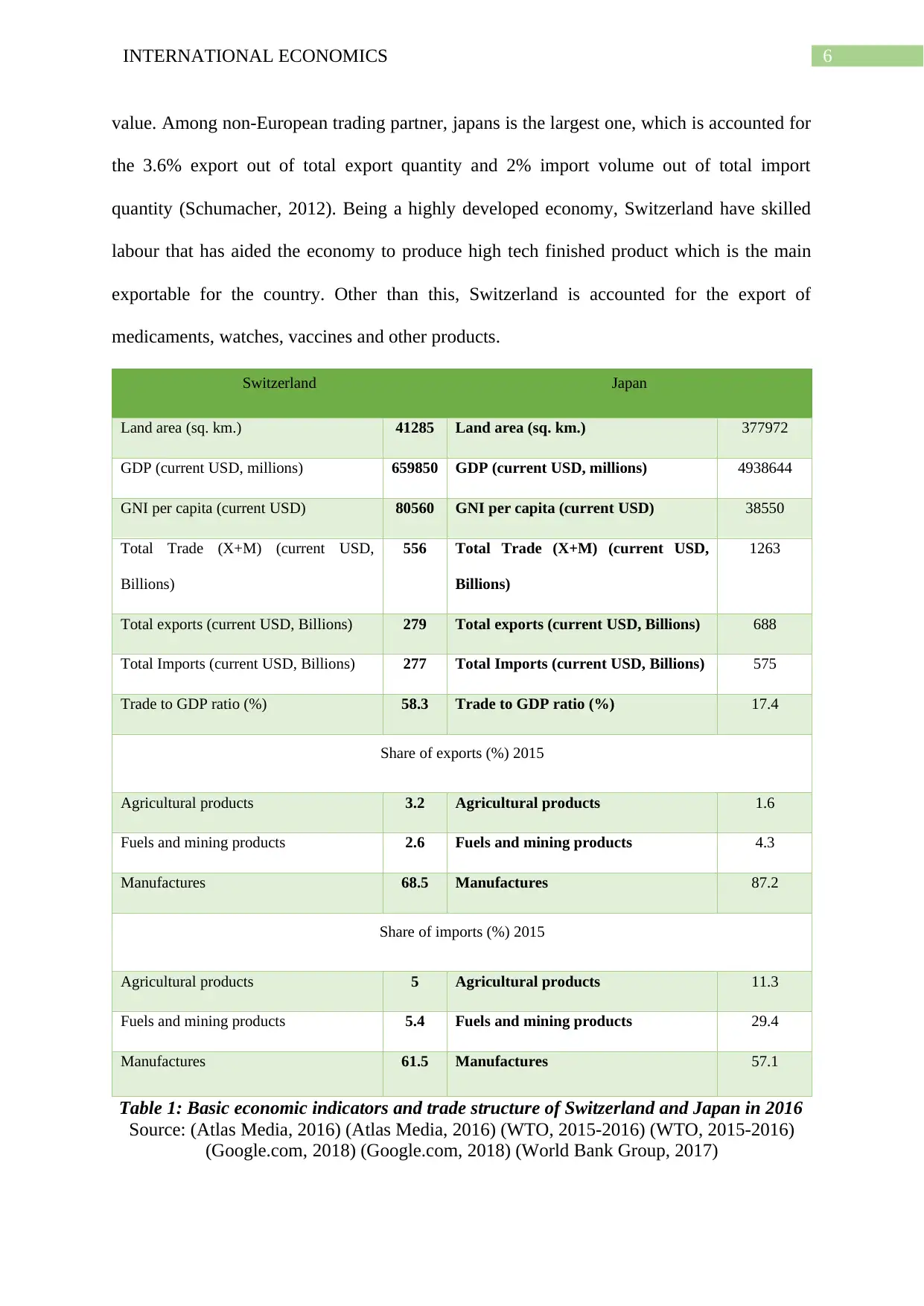
6INTERNATIONAL ECONOMICS
value. Among non-European trading partner, japans is the largest one, which is accounted for
the 3.6% export out of total export quantity and 2% import volume out of total import
quantity (Schumacher, 2012). Being a highly developed economy, Switzerland have skilled
labour that has aided the economy to produce high tech finished product which is the main
exportable for the country. Other than this, Switzerland is accounted for the export of
medicaments, watches, vaccines and other products.
Switzerland Japan
Land area (sq. km.) 41285 Land area (sq. km.) 377972
GDP (current USD, millions) 659850 GDP (current USD, millions) 4938644
GNI per capita (current USD) 80560 GNI per capita (current USD) 38550
Total Trade (X+M) (current USD,
Billions)
556 Total Trade (X+M) (current USD,
Billions)
1263
Total exports (current USD, Billions) 279 Total exports (current USD, Billions) 688
Total Imports (current USD, Billions) 277 Total Imports (current USD, Billions) 575
Trade to GDP ratio (%) 58.3 Trade to GDP ratio (%) 17.4
Share of exports (%) 2015
Agricultural products 3.2 Agricultural products 1.6
Fuels and mining products 2.6 Fuels and mining products 4.3
Manufactures 68.5 Manufactures 87.2
Share of imports (%) 2015
Agricultural products 5 Agricultural products 11.3
Fuels and mining products 5.4 Fuels and mining products 29.4
Manufactures 61.5 Manufactures 57.1
Table 1: Basic economic indicators and trade structure of Switzerland and Japan in 2016
Source: (Atlas Media, 2016) (Atlas Media, 2016) (WTO, 2015-2016) (WTO, 2015-2016)
(Google.com, 2018) (Google.com, 2018) (World Bank Group, 2017)
value. Among non-European trading partner, japans is the largest one, which is accounted for
the 3.6% export out of total export quantity and 2% import volume out of total import
quantity (Schumacher, 2012). Being a highly developed economy, Switzerland have skilled
labour that has aided the economy to produce high tech finished product which is the main
exportable for the country. Other than this, Switzerland is accounted for the export of
medicaments, watches, vaccines and other products.
Switzerland Japan
Land area (sq. km.) 41285 Land area (sq. km.) 377972
GDP (current USD, millions) 659850 GDP (current USD, millions) 4938644
GNI per capita (current USD) 80560 GNI per capita (current USD) 38550
Total Trade (X+M) (current USD,
Billions)
556 Total Trade (X+M) (current USD,
Billions)
1263
Total exports (current USD, Billions) 279 Total exports (current USD, Billions) 688
Total Imports (current USD, Billions) 277 Total Imports (current USD, Billions) 575
Trade to GDP ratio (%) 58.3 Trade to GDP ratio (%) 17.4
Share of exports (%) 2015
Agricultural products 3.2 Agricultural products 1.6
Fuels and mining products 2.6 Fuels and mining products 4.3
Manufactures 68.5 Manufactures 87.2
Share of imports (%) 2015
Agricultural products 5 Agricultural products 11.3
Fuels and mining products 5.4 Fuels and mining products 29.4
Manufactures 61.5 Manufactures 57.1
Table 1: Basic economic indicators and trade structure of Switzerland and Japan in 2016
Source: (Atlas Media, 2016) (Atlas Media, 2016) (WTO, 2015-2016) (WTO, 2015-2016)
(Google.com, 2018) (Google.com, 2018) (World Bank Group, 2017)
Paraphrase This Document
Need a fresh take? Get an instant paraphrase of this document with our AI Paraphraser
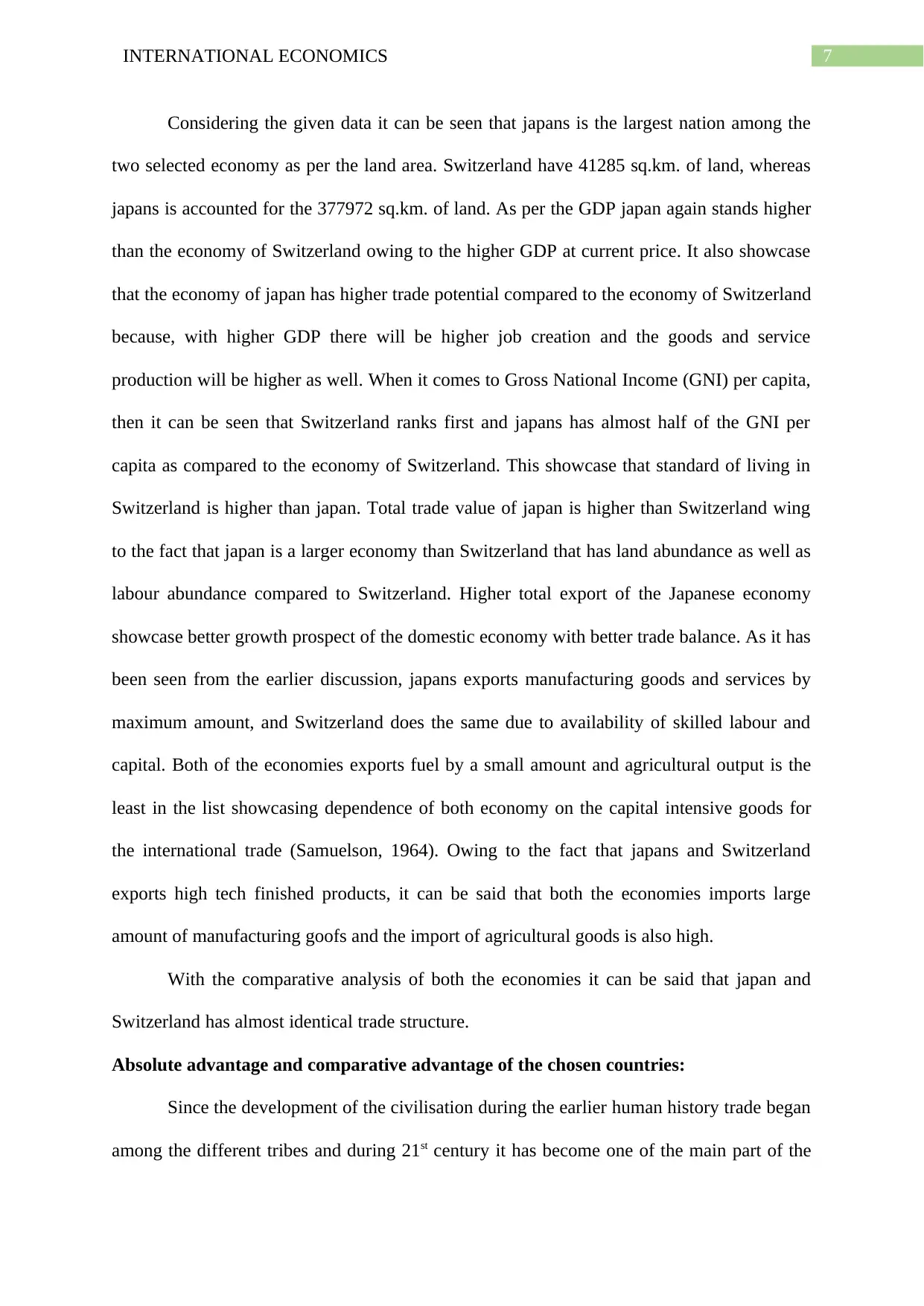
7INTERNATIONAL ECONOMICS
Considering the given data it can be seen that japans is the largest nation among the
two selected economy as per the land area. Switzerland have 41285 sq.km. of land, whereas
japans is accounted for the 377972 sq.km. of land. As per the GDP japan again stands higher
than the economy of Switzerland owing to the higher GDP at current price. It also showcase
that the economy of japan has higher trade potential compared to the economy of Switzerland
because, with higher GDP there will be higher job creation and the goods and service
production will be higher as well. When it comes to Gross National Income (GNI) per capita,
then it can be seen that Switzerland ranks first and japans has almost half of the GNI per
capita as compared to the economy of Switzerland. This showcase that standard of living in
Switzerland is higher than japan. Total trade value of japan is higher than Switzerland wing
to the fact that japan is a larger economy than Switzerland that has land abundance as well as
labour abundance compared to Switzerland. Higher total export of the Japanese economy
showcase better growth prospect of the domestic economy with better trade balance. As it has
been seen from the earlier discussion, japans exports manufacturing goods and services by
maximum amount, and Switzerland does the same due to availability of skilled labour and
capital. Both of the economies exports fuel by a small amount and agricultural output is the
least in the list showcasing dependence of both economy on the capital intensive goods for
the international trade (Samuelson, 1964). Owing to the fact that japans and Switzerland
exports high tech finished products, it can be said that both the economies imports large
amount of manufacturing goofs and the import of agricultural goods is also high.
With the comparative analysis of both the economies it can be said that japan and
Switzerland has almost identical trade structure.
Absolute advantage and comparative advantage of the chosen countries:
Since the development of the civilisation during the earlier human history trade began
among the different tribes and during 21st century it has become one of the main part of the
Considering the given data it can be seen that japans is the largest nation among the
two selected economy as per the land area. Switzerland have 41285 sq.km. of land, whereas
japans is accounted for the 377972 sq.km. of land. As per the GDP japan again stands higher
than the economy of Switzerland owing to the higher GDP at current price. It also showcase
that the economy of japan has higher trade potential compared to the economy of Switzerland
because, with higher GDP there will be higher job creation and the goods and service
production will be higher as well. When it comes to Gross National Income (GNI) per capita,
then it can be seen that Switzerland ranks first and japans has almost half of the GNI per
capita as compared to the economy of Switzerland. This showcase that standard of living in
Switzerland is higher than japan. Total trade value of japan is higher than Switzerland wing
to the fact that japan is a larger economy than Switzerland that has land abundance as well as
labour abundance compared to Switzerland. Higher total export of the Japanese economy
showcase better growth prospect of the domestic economy with better trade balance. As it has
been seen from the earlier discussion, japans exports manufacturing goods and services by
maximum amount, and Switzerland does the same due to availability of skilled labour and
capital. Both of the economies exports fuel by a small amount and agricultural output is the
least in the list showcasing dependence of both economy on the capital intensive goods for
the international trade (Samuelson, 1964). Owing to the fact that japans and Switzerland
exports high tech finished products, it can be said that both the economies imports large
amount of manufacturing goofs and the import of agricultural goods is also high.
With the comparative analysis of both the economies it can be said that japan and
Switzerland has almost identical trade structure.
Absolute advantage and comparative advantage of the chosen countries:
Since the development of the civilisation during the earlier human history trade began
among the different tribes and during 21st century it has become one of the main part of the
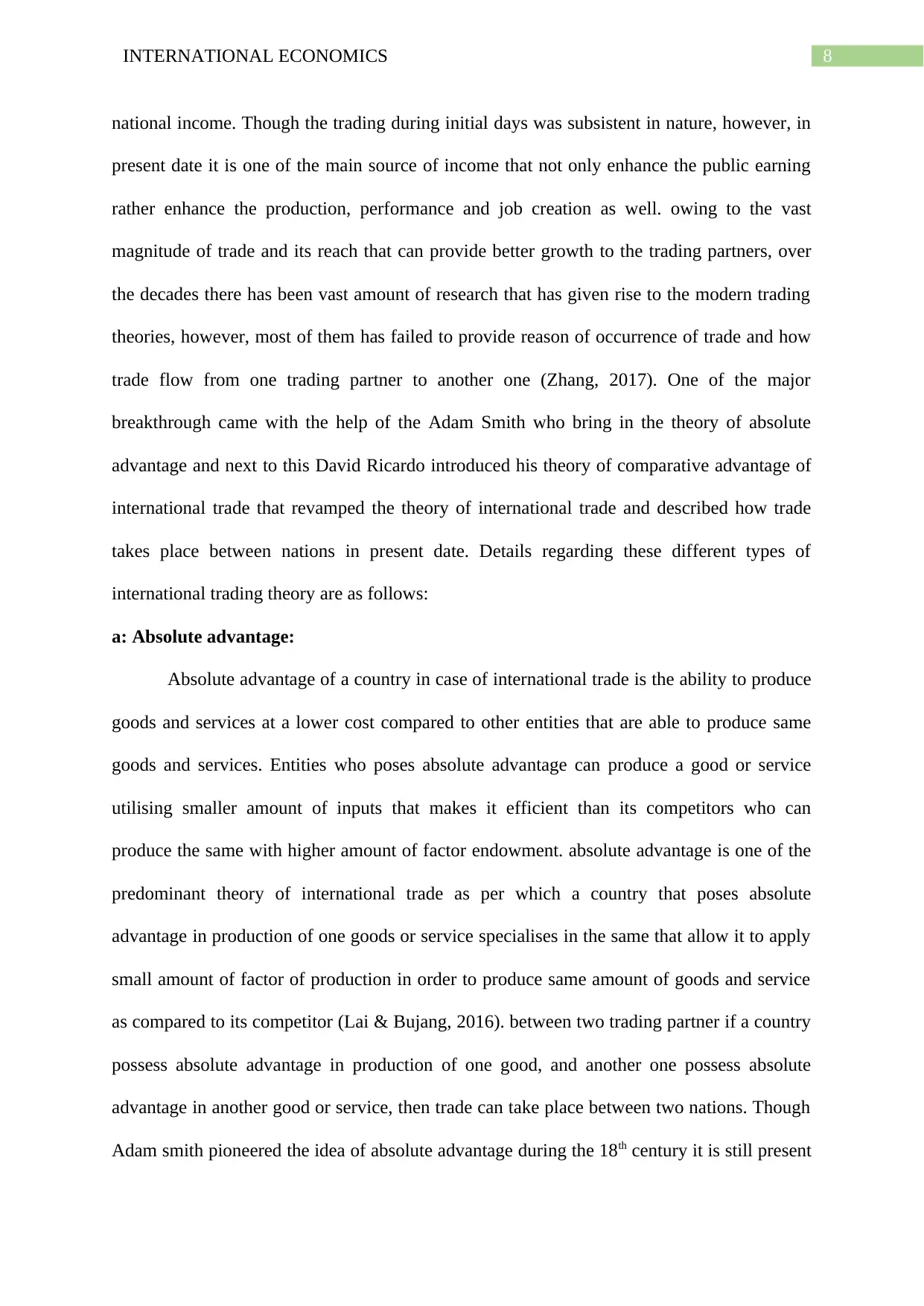
8INTERNATIONAL ECONOMICS
national income. Though the trading during initial days was subsistent in nature, however, in
present date it is one of the main source of income that not only enhance the public earning
rather enhance the production, performance and job creation as well. owing to the vast
magnitude of trade and its reach that can provide better growth to the trading partners, over
the decades there has been vast amount of research that has given rise to the modern trading
theories, however, most of them has failed to provide reason of occurrence of trade and how
trade flow from one trading partner to another one (Zhang, 2017). One of the major
breakthrough came with the help of the Adam Smith who bring in the theory of absolute
advantage and next to this David Ricardo introduced his theory of comparative advantage of
international trade that revamped the theory of international trade and described how trade
takes place between nations in present date. Details regarding these different types of
international trading theory are as follows:
a: Absolute advantage:
Absolute advantage of a country in case of international trade is the ability to produce
goods and services at a lower cost compared to other entities that are able to produce same
goods and services. Entities who poses absolute advantage can produce a good or service
utilising smaller amount of inputs that makes it efficient than its competitors who can
produce the same with higher amount of factor endowment. absolute advantage is one of the
predominant theory of international trade as per which a country that poses absolute
advantage in production of one goods or service specialises in the same that allow it to apply
small amount of factor of production in order to produce same amount of goods and service
as compared to its competitor (Lai & Bujang, 2016). between two trading partner if a country
possess absolute advantage in production of one good, and another one possess absolute
advantage in another good or service, then trade can take place between two nations. Though
Adam smith pioneered the idea of absolute advantage during the 18th century it is still present
national income. Though the trading during initial days was subsistent in nature, however, in
present date it is one of the main source of income that not only enhance the public earning
rather enhance the production, performance and job creation as well. owing to the vast
magnitude of trade and its reach that can provide better growth to the trading partners, over
the decades there has been vast amount of research that has given rise to the modern trading
theories, however, most of them has failed to provide reason of occurrence of trade and how
trade flow from one trading partner to another one (Zhang, 2017). One of the major
breakthrough came with the help of the Adam Smith who bring in the theory of absolute
advantage and next to this David Ricardo introduced his theory of comparative advantage of
international trade that revamped the theory of international trade and described how trade
takes place between nations in present date. Details regarding these different types of
international trading theory are as follows:
a: Absolute advantage:
Absolute advantage of a country in case of international trade is the ability to produce
goods and services at a lower cost compared to other entities that are able to produce same
goods and services. Entities who poses absolute advantage can produce a good or service
utilising smaller amount of inputs that makes it efficient than its competitors who can
produce the same with higher amount of factor endowment. absolute advantage is one of the
predominant theory of international trade as per which a country that poses absolute
advantage in production of one goods or service specialises in the same that allow it to apply
small amount of factor of production in order to produce same amount of goods and service
as compared to its competitor (Lai & Bujang, 2016). between two trading partner if a country
possess absolute advantage in production of one good, and another one possess absolute
advantage in another good or service, then trade can take place between two nations. Though
Adam smith pioneered the idea of absolute advantage during the 18th century it is still present
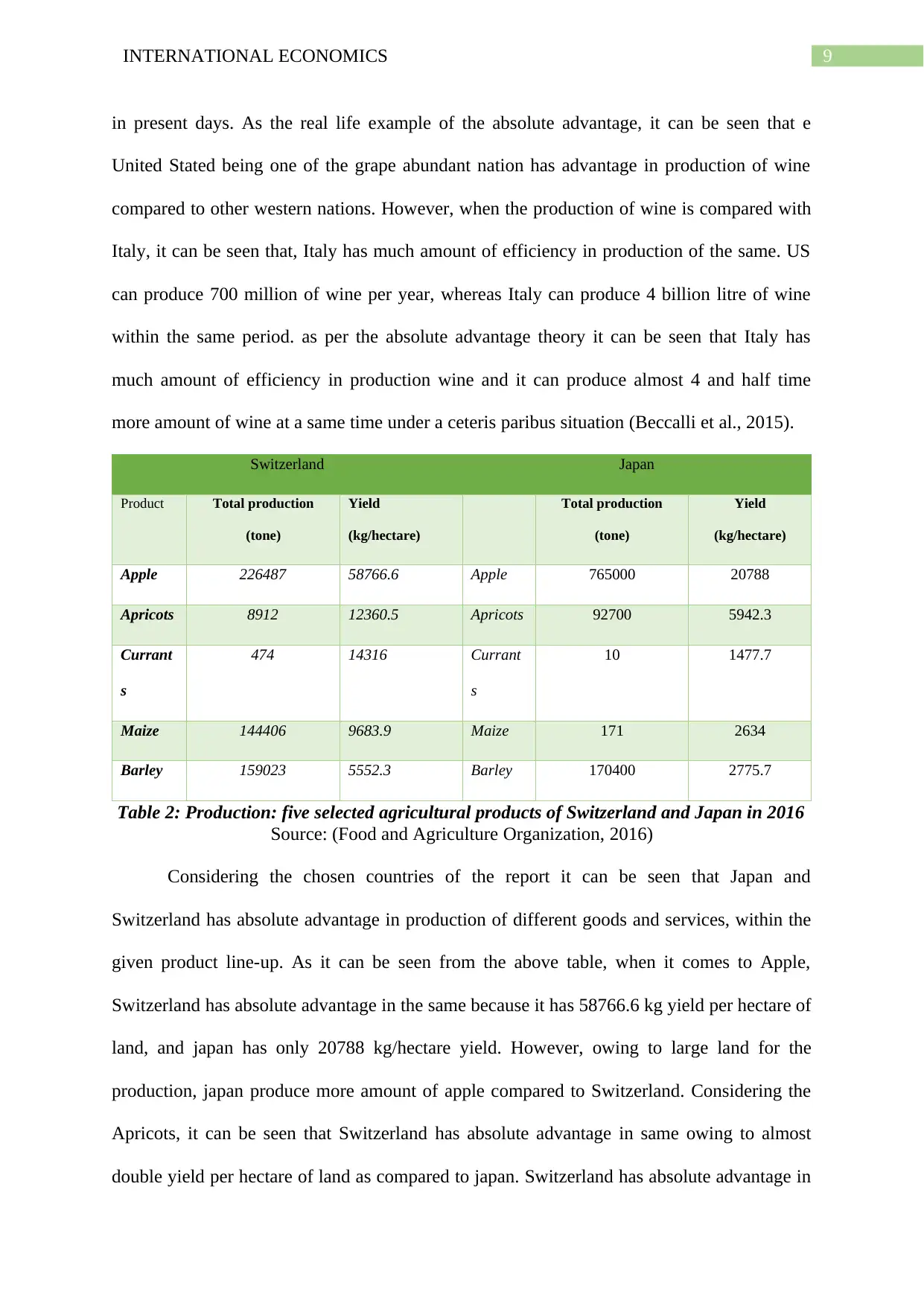
9INTERNATIONAL ECONOMICS
in present days. As the real life example of the absolute advantage, it can be seen that e
United Stated being one of the grape abundant nation has advantage in production of wine
compared to other western nations. However, when the production of wine is compared with
Italy, it can be seen that, Italy has much amount of efficiency in production of the same. US
can produce 700 million of wine per year, whereas Italy can produce 4 billion litre of wine
within the same period. as per the absolute advantage theory it can be seen that Italy has
much amount of efficiency in production wine and it can produce almost 4 and half time
more amount of wine at a same time under a ceteris paribus situation (Beccalli et al., 2015).
Switzerland Japan
Product Total production
(tone)
Yield
(kg/hectare)
Total production
(tone)
Yield
(kg/hectare)
Apple 226487 58766.6 Apple 765000 20788
Apricots 8912 12360.5 Apricots 92700 5942.3
Currant
s
474 14316 Currant
s
10 1477.7
Maize 144406 9683.9 Maize 171 2634
Barley 159023 5552.3 Barley 170400 2775.7
Table 2: Production: five selected agricultural products of Switzerland and Japan in 2016
Source: (Food and Agriculture Organization, 2016)
Considering the chosen countries of the report it can be seen that Japan and
Switzerland has absolute advantage in production of different goods and services, within the
given product line-up. As it can be seen from the above table, when it comes to Apple,
Switzerland has absolute advantage in the same because it has 58766.6 kg yield per hectare of
land, and japan has only 20788 kg/hectare yield. However, owing to large land for the
production, japan produce more amount of apple compared to Switzerland. Considering the
Apricots, it can be seen that Switzerland has absolute advantage in same owing to almost
double yield per hectare of land as compared to japan. Switzerland has absolute advantage in
in present days. As the real life example of the absolute advantage, it can be seen that e
United Stated being one of the grape abundant nation has advantage in production of wine
compared to other western nations. However, when the production of wine is compared with
Italy, it can be seen that, Italy has much amount of efficiency in production of the same. US
can produce 700 million of wine per year, whereas Italy can produce 4 billion litre of wine
within the same period. as per the absolute advantage theory it can be seen that Italy has
much amount of efficiency in production wine and it can produce almost 4 and half time
more amount of wine at a same time under a ceteris paribus situation (Beccalli et al., 2015).
Switzerland Japan
Product Total production
(tone)
Yield
(kg/hectare)
Total production
(tone)
Yield
(kg/hectare)
Apple 226487 58766.6 Apple 765000 20788
Apricots 8912 12360.5 Apricots 92700 5942.3
Currant
s
474 14316 Currant
s
10 1477.7
Maize 144406 9683.9 Maize 171 2634
Barley 159023 5552.3 Barley 170400 2775.7
Table 2: Production: five selected agricultural products of Switzerland and Japan in 2016
Source: (Food and Agriculture Organization, 2016)
Considering the chosen countries of the report it can be seen that Japan and
Switzerland has absolute advantage in production of different goods and services, within the
given product line-up. As it can be seen from the above table, when it comes to Apple,
Switzerland has absolute advantage in the same because it has 58766.6 kg yield per hectare of
land, and japan has only 20788 kg/hectare yield. However, owing to large land for the
production, japan produce more amount of apple compared to Switzerland. Considering the
Apricots, it can be seen that Switzerland has absolute advantage in same owing to almost
double yield per hectare of land as compared to japan. Switzerland has absolute advantage in
Secure Best Marks with AI Grader
Need help grading? Try our AI Grader for instant feedback on your assignments.
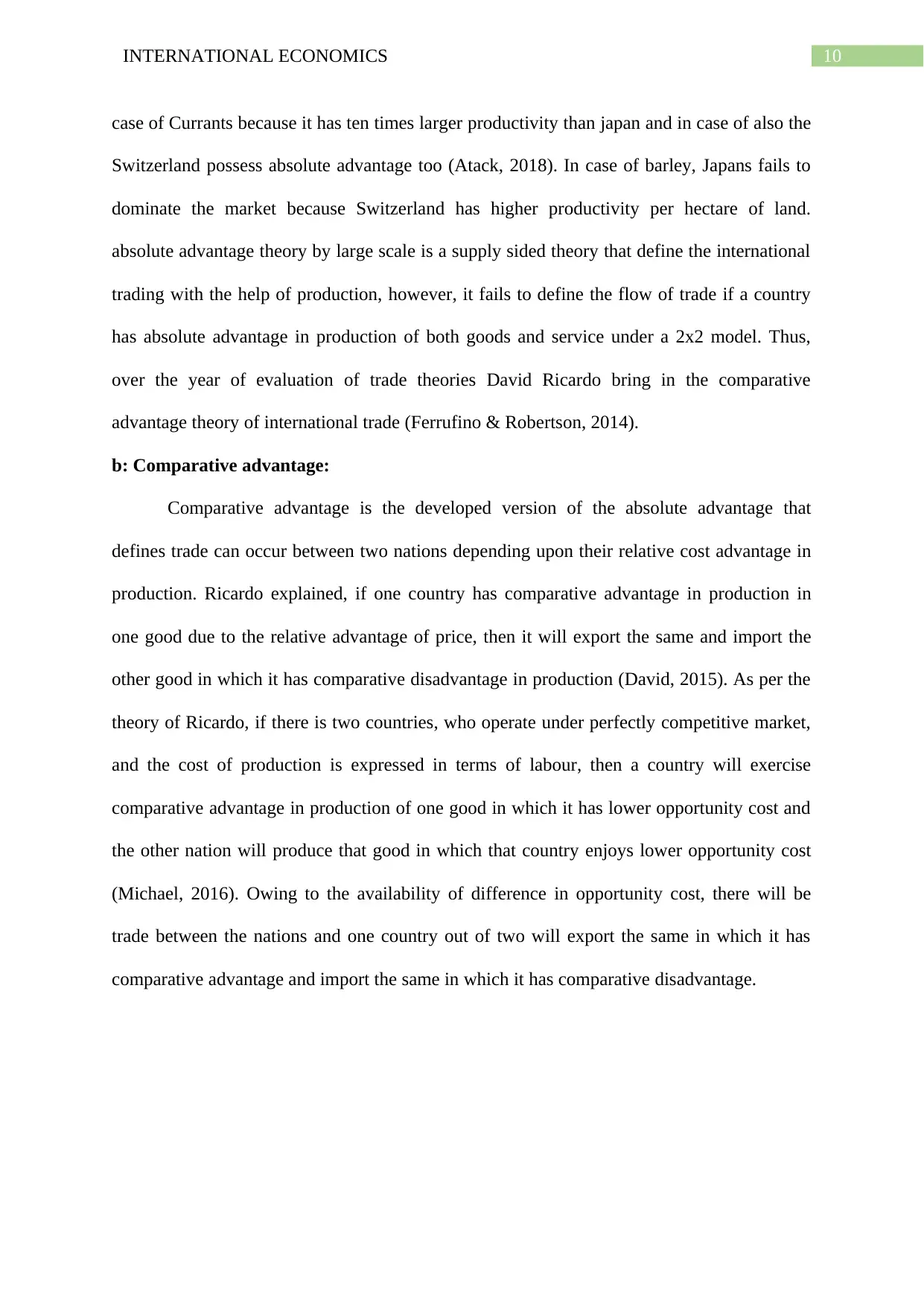
10INTERNATIONAL ECONOMICS
case of Currants because it has ten times larger productivity than japan and in case of also the
Switzerland possess absolute advantage too (Atack, 2018). In case of barley, Japans fails to
dominate the market because Switzerland has higher productivity per hectare of land.
absolute advantage theory by large scale is a supply sided theory that define the international
trading with the help of production, however, it fails to define the flow of trade if a country
has absolute advantage in production of both goods and service under a 2x2 model. Thus,
over the year of evaluation of trade theories David Ricardo bring in the comparative
advantage theory of international trade (Ferrufino & Robertson, 2014).
b: Comparative advantage:
Comparative advantage is the developed version of the absolute advantage that
defines trade can occur between two nations depending upon their relative cost advantage in
production. Ricardo explained, if one country has comparative advantage in production in
one good due to the relative advantage of price, then it will export the same and import the
other good in which it has comparative disadvantage in production (David, 2015). As per the
theory of Ricardo, if there is two countries, who operate under perfectly competitive market,
and the cost of production is expressed in terms of labour, then a country will exercise
comparative advantage in production of one good in which it has lower opportunity cost and
the other nation will produce that good in which that country enjoys lower opportunity cost
(Michael, 2016). Owing to the availability of difference in opportunity cost, there will be
trade between the nations and one country out of two will export the same in which it has
comparative advantage and import the same in which it has comparative disadvantage.
case of Currants because it has ten times larger productivity than japan and in case of also the
Switzerland possess absolute advantage too (Atack, 2018). In case of barley, Japans fails to
dominate the market because Switzerland has higher productivity per hectare of land.
absolute advantage theory by large scale is a supply sided theory that define the international
trading with the help of production, however, it fails to define the flow of trade if a country
has absolute advantage in production of both goods and service under a 2x2 model. Thus,
over the year of evaluation of trade theories David Ricardo bring in the comparative
advantage theory of international trade (Ferrufino & Robertson, 2014).
b: Comparative advantage:
Comparative advantage is the developed version of the absolute advantage that
defines trade can occur between two nations depending upon their relative cost advantage in
production. Ricardo explained, if one country has comparative advantage in production in
one good due to the relative advantage of price, then it will export the same and import the
other good in which it has comparative disadvantage in production (David, 2015). As per the
theory of Ricardo, if there is two countries, who operate under perfectly competitive market,
and the cost of production is expressed in terms of labour, then a country will exercise
comparative advantage in production of one good in which it has lower opportunity cost and
the other nation will produce that good in which that country enjoys lower opportunity cost
(Michael, 2016). Owing to the availability of difference in opportunity cost, there will be
trade between the nations and one country out of two will export the same in which it has
comparative advantage and import the same in which it has comparative disadvantage.
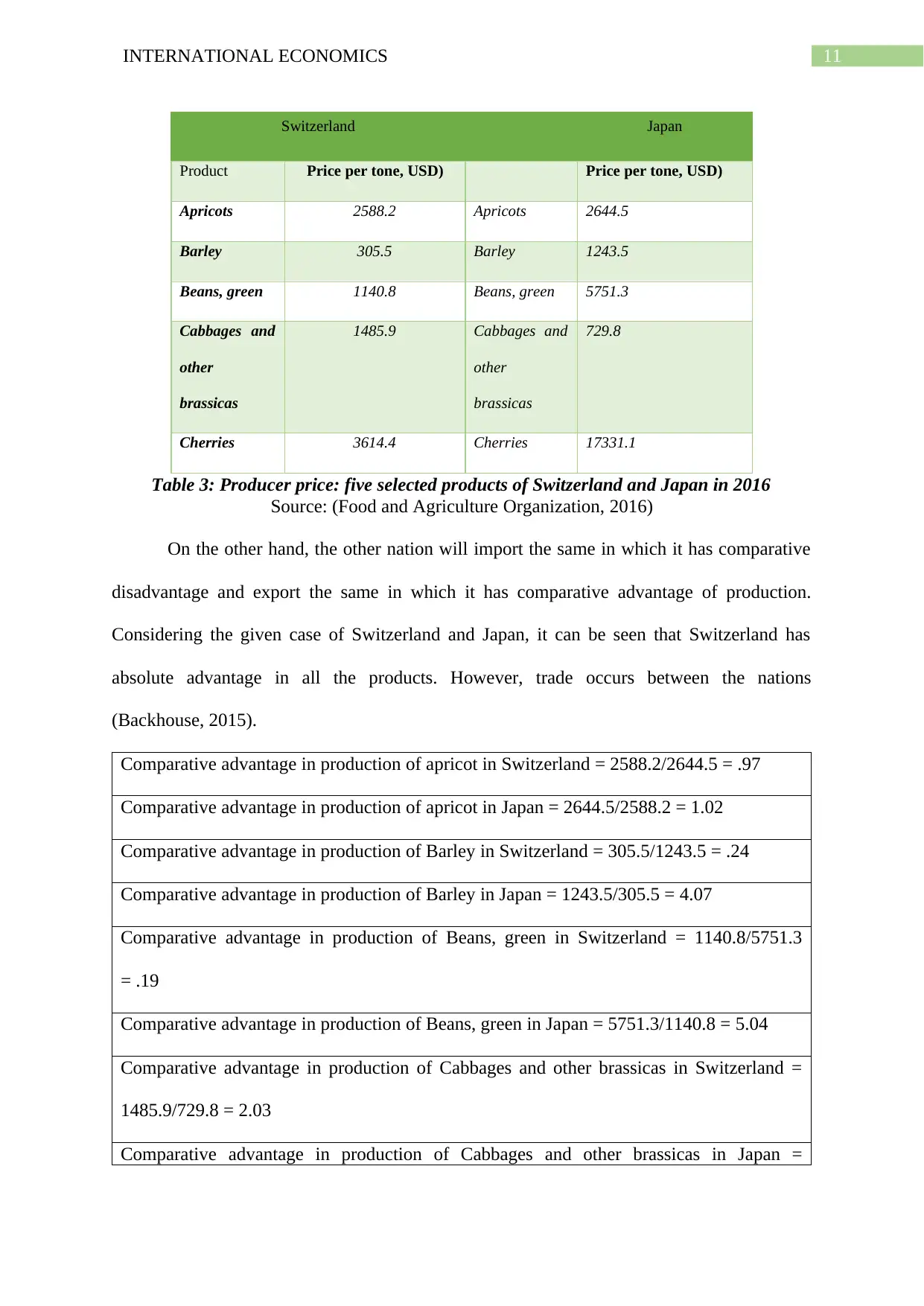
11INTERNATIONAL ECONOMICS
Switzerland Japan
Product Price per tone, USD) Price per tone, USD)
Apricots 2588.2 Apricots 2644.5
Barley 305.5 Barley 1243.5
Beans, green 1140.8 Beans, green 5751.3
Cabbages and
other
brassicas
1485.9 Cabbages and
other
brassicas
729.8
Cherries 3614.4 Cherries 17331.1
Table 3: Producer price: five selected products of Switzerland and Japan in 2016
Source: (Food and Agriculture Organization, 2016)
On the other hand, the other nation will import the same in which it has comparative
disadvantage and export the same in which it has comparative advantage of production.
Considering the given case of Switzerland and Japan, it can be seen that Switzerland has
absolute advantage in all the products. However, trade occurs between the nations
(Backhouse, 2015).
Comparative advantage in production of apricot in Switzerland = 2588.2/2644.5 = .97
Comparative advantage in production of apricot in Japan = 2644.5/2588.2 = 1.02
Comparative advantage in production of Barley in Switzerland = 305.5/1243.5 = .24
Comparative advantage in production of Barley in Japan = 1243.5/305.5 = 4.07
Comparative advantage in production of Beans, green in Switzerland = 1140.8/5751.3
= .19
Comparative advantage in production of Beans, green in Japan = 5751.3/1140.8 = 5.04
Comparative advantage in production of Cabbages and other brassicas in Switzerland =
1485.9/729.8 = 2.03
Comparative advantage in production of Cabbages and other brassicas in Japan =
Switzerland Japan
Product Price per tone, USD) Price per tone, USD)
Apricots 2588.2 Apricots 2644.5
Barley 305.5 Barley 1243.5
Beans, green 1140.8 Beans, green 5751.3
Cabbages and
other
brassicas
1485.9 Cabbages and
other
brassicas
729.8
Cherries 3614.4 Cherries 17331.1
Table 3: Producer price: five selected products of Switzerland and Japan in 2016
Source: (Food and Agriculture Organization, 2016)
On the other hand, the other nation will import the same in which it has comparative
disadvantage and export the same in which it has comparative advantage of production.
Considering the given case of Switzerland and Japan, it can be seen that Switzerland has
absolute advantage in all the products. However, trade occurs between the nations
(Backhouse, 2015).
Comparative advantage in production of apricot in Switzerland = 2588.2/2644.5 = .97
Comparative advantage in production of apricot in Japan = 2644.5/2588.2 = 1.02
Comparative advantage in production of Barley in Switzerland = 305.5/1243.5 = .24
Comparative advantage in production of Barley in Japan = 1243.5/305.5 = 4.07
Comparative advantage in production of Beans, green in Switzerland = 1140.8/5751.3
= .19
Comparative advantage in production of Beans, green in Japan = 5751.3/1140.8 = 5.04
Comparative advantage in production of Cabbages and other brassicas in Switzerland =
1485.9/729.8 = 2.03
Comparative advantage in production of Cabbages and other brassicas in Japan =
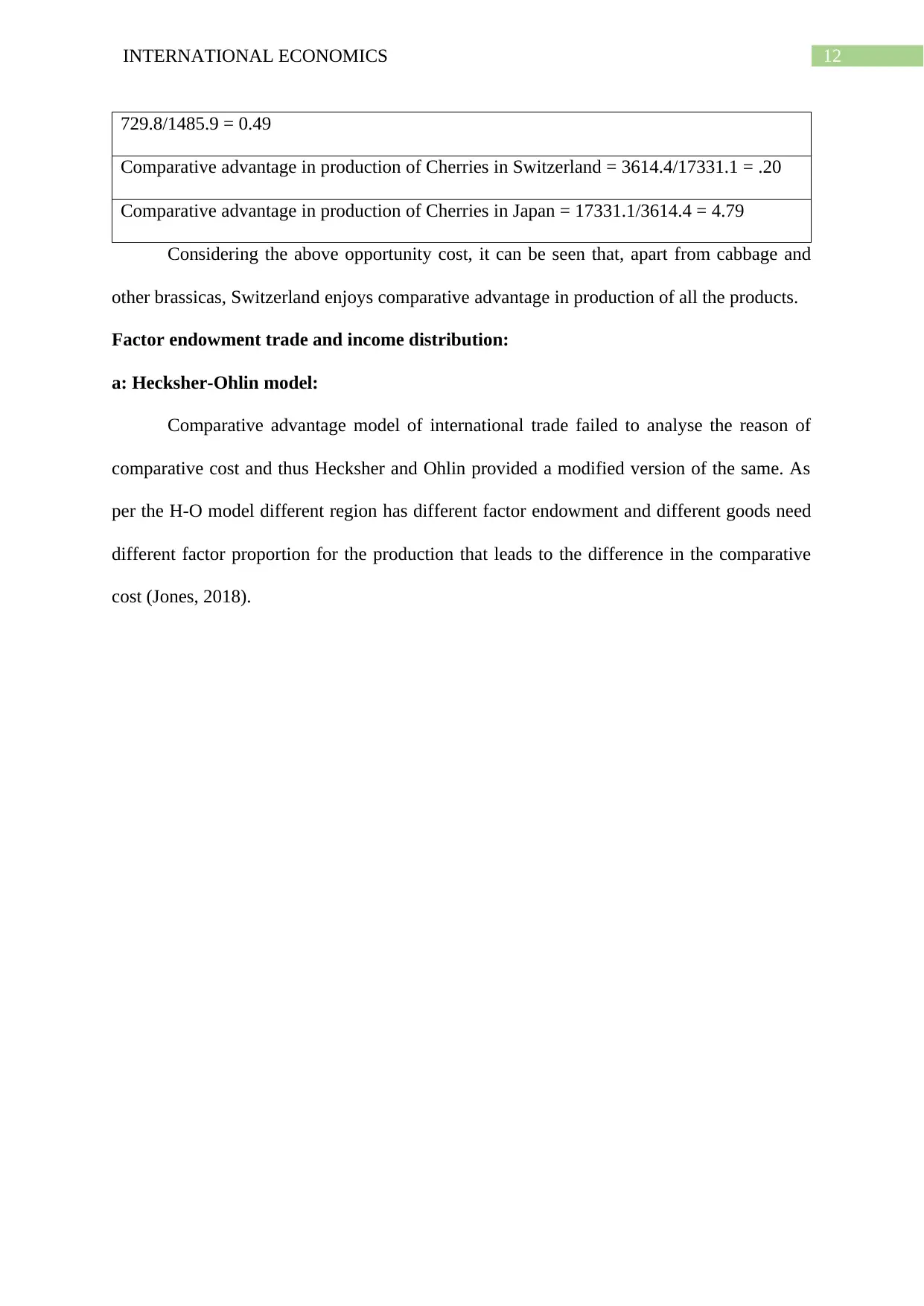
12INTERNATIONAL ECONOMICS
729.8/1485.9 = 0.49
Comparative advantage in production of Cherries in Switzerland = 3614.4/17331.1 = .20
Comparative advantage in production of Cherries in Japan = 17331.1/3614.4 = 4.79
Considering the above opportunity cost, it can be seen that, apart from cabbage and
other brassicas, Switzerland enjoys comparative advantage in production of all the products.
Factor endowment trade and income distribution:
a: Hecksher-Ohlin model:
Comparative advantage model of international trade failed to analyse the reason of
comparative cost and thus Hecksher and Ohlin provided a modified version of the same. As
per the H-O model different region has different factor endowment and different goods need
different factor proportion for the production that leads to the difference in the comparative
cost (Jones, 2018).
729.8/1485.9 = 0.49
Comparative advantage in production of Cherries in Switzerland = 3614.4/17331.1 = .20
Comparative advantage in production of Cherries in Japan = 17331.1/3614.4 = 4.79
Considering the above opportunity cost, it can be seen that, apart from cabbage and
other brassicas, Switzerland enjoys comparative advantage in production of all the products.
Factor endowment trade and income distribution:
a: Hecksher-Ohlin model:
Comparative advantage model of international trade failed to analyse the reason of
comparative cost and thus Hecksher and Ohlin provided a modified version of the same. As
per the H-O model different region has different factor endowment and different goods need
different factor proportion for the production that leads to the difference in the comparative
cost (Jones, 2018).
Paraphrase This Document
Need a fresh take? Get an instant paraphrase of this document with our AI Paraphraser
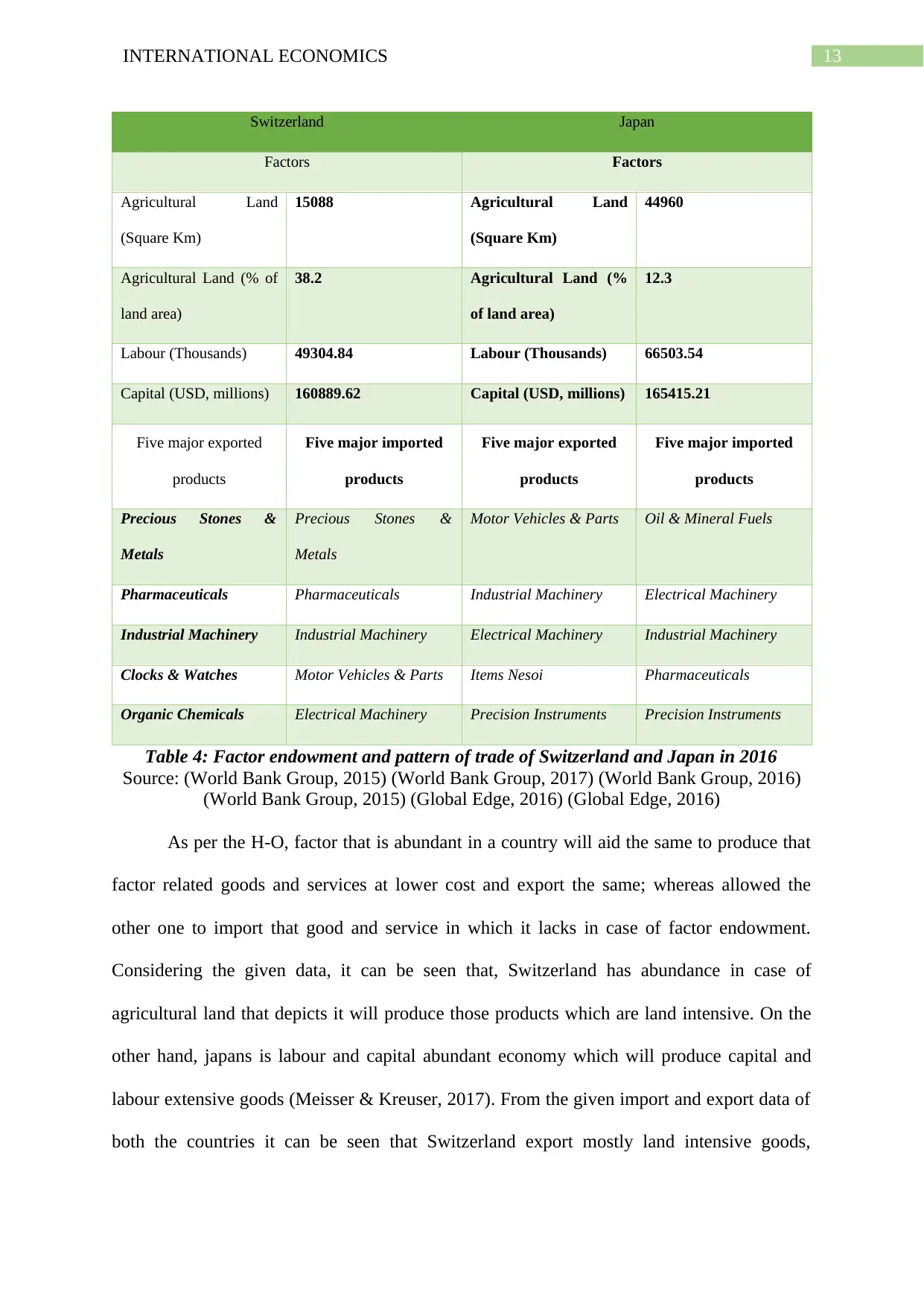
13INTERNATIONAL ECONOMICS
Switzerland Japan
Factors Factors
Agricultural Land
(Square Km)
15088 Agricultural Land
(Square Km)
44960
Agricultural Land (% of
land area)
38.2 Agricultural Land (%
of land area)
12.3
Labour (Thousands) 49304.84 Labour (Thousands) 66503.54
Capital (USD, millions) 160889.62 Capital (USD, millions) 165415.21
Five major exported
products
Five major imported
products
Five major exported
products
Five major imported
products
Precious Stones &
Metals
Precious Stones &
Metals
Motor Vehicles & Parts Oil & Mineral Fuels
Pharmaceuticals Pharmaceuticals Industrial Machinery Electrical Machinery
Industrial Machinery Industrial Machinery Electrical Machinery Industrial Machinery
Clocks & Watches Motor Vehicles & Parts Items Nesoi Pharmaceuticals
Organic Chemicals Electrical Machinery Precision Instruments Precision Instruments
Table 4: Factor endowment and pattern of trade of Switzerland and Japan in 2016
Source: (World Bank Group, 2015) (World Bank Group, 2017) (World Bank Group, 2016)
(World Bank Group, 2015) (Global Edge, 2016) (Global Edge, 2016)
As per the H-O, factor that is abundant in a country will aid the same to produce that
factor related goods and services at lower cost and export the same; whereas allowed the
other one to import that good and service in which it lacks in case of factor endowment.
Considering the given data, it can be seen that, Switzerland has abundance in case of
agricultural land that depicts it will produce those products which are land intensive. On the
other hand, japans is labour and capital abundant economy which will produce capital and
labour extensive goods (Meisser & Kreuser, 2017). From the given import and export data of
both the countries it can be seen that Switzerland export mostly land intensive goods,
Switzerland Japan
Factors Factors
Agricultural Land
(Square Km)
15088 Agricultural Land
(Square Km)
44960
Agricultural Land (% of
land area)
38.2 Agricultural Land (%
of land area)
12.3
Labour (Thousands) 49304.84 Labour (Thousands) 66503.54
Capital (USD, millions) 160889.62 Capital (USD, millions) 165415.21
Five major exported
products
Five major imported
products
Five major exported
products
Five major imported
products
Precious Stones &
Metals
Precious Stones &
Metals
Motor Vehicles & Parts Oil & Mineral Fuels
Pharmaceuticals Pharmaceuticals Industrial Machinery Electrical Machinery
Industrial Machinery Industrial Machinery Electrical Machinery Industrial Machinery
Clocks & Watches Motor Vehicles & Parts Items Nesoi Pharmaceuticals
Organic Chemicals Electrical Machinery Precision Instruments Precision Instruments
Table 4: Factor endowment and pattern of trade of Switzerland and Japan in 2016
Source: (World Bank Group, 2015) (World Bank Group, 2017) (World Bank Group, 2016)
(World Bank Group, 2015) (Global Edge, 2016) (Global Edge, 2016)
As per the H-O, factor that is abundant in a country will aid the same to produce that
factor related goods and services at lower cost and export the same; whereas allowed the
other one to import that good and service in which it lacks in case of factor endowment.
Considering the given data, it can be seen that, Switzerland has abundance in case of
agricultural land that depicts it will produce those products which are land intensive. On the
other hand, japans is labour and capital abundant economy which will produce capital and
labour extensive goods (Meisser & Kreuser, 2017). From the given import and export data of
both the countries it can be seen that Switzerland export mostly land intensive goods,
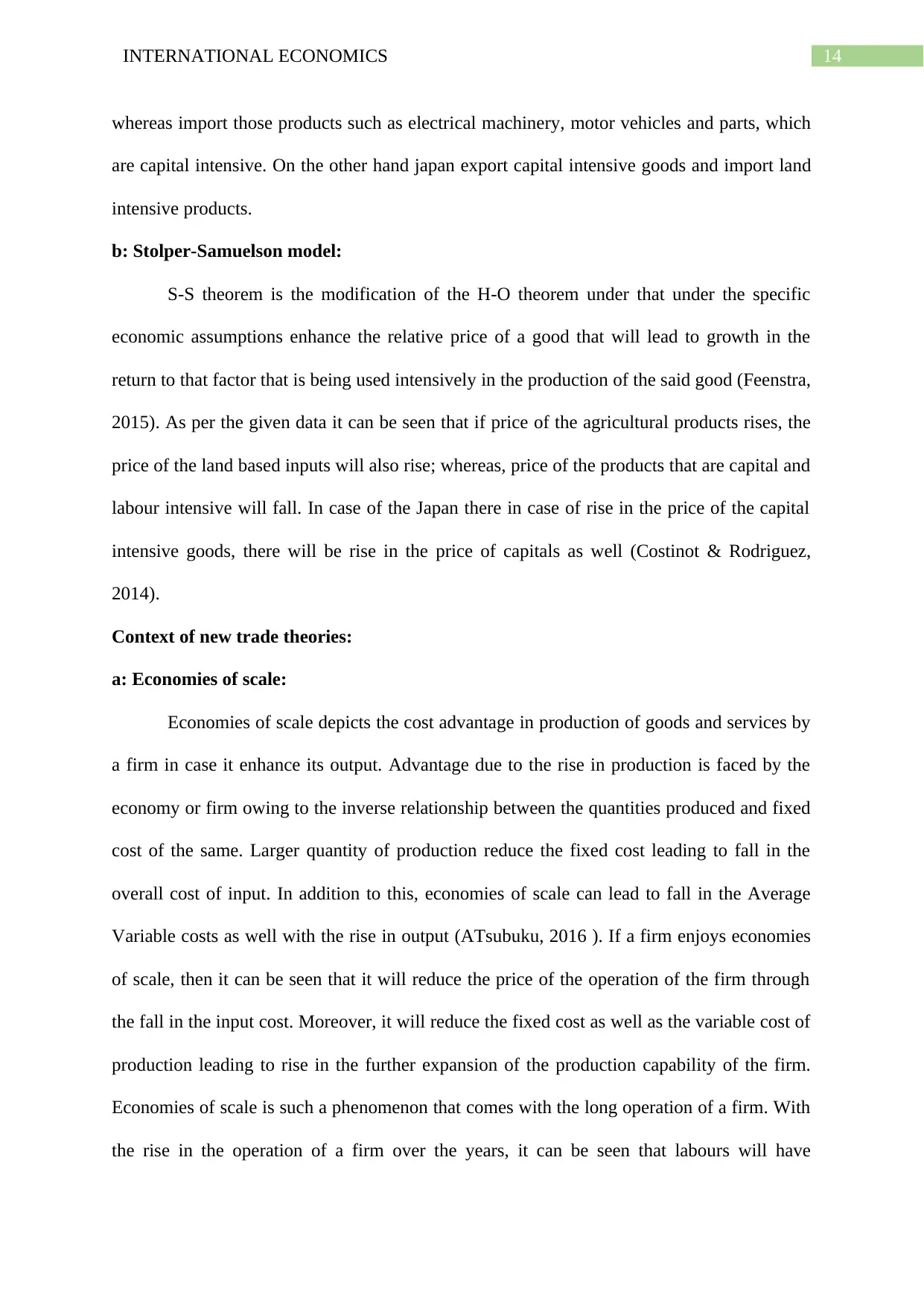
14INTERNATIONAL ECONOMICS
whereas import those products such as electrical machinery, motor vehicles and parts, which
are capital intensive. On the other hand japan export capital intensive goods and import land
intensive products.
b: Stolper-Samuelson model:
S-S theorem is the modification of the H-O theorem under that under the specific
economic assumptions enhance the relative price of a good that will lead to growth in the
return to that factor that is being used intensively in the production of the said good (Feenstra,
2015). As per the given data it can be seen that if price of the agricultural products rises, the
price of the land based inputs will also rise; whereas, price of the products that are capital and
labour intensive will fall. In case of the Japan there in case of rise in the price of the capital
intensive goods, there will be rise in the price of capitals as well (Costinot & Rodriguez,
2014).
Context of new trade theories:
a: Economies of scale:
Economies of scale depicts the cost advantage in production of goods and services by
a firm in case it enhance its output. Advantage due to the rise in production is faced by the
economy or firm owing to the inverse relationship between the quantities produced and fixed
cost of the same. Larger quantity of production reduce the fixed cost leading to fall in the
overall cost of input. In addition to this, economies of scale can lead to fall in the Average
Variable costs as well with the rise in output (ATsubuku, 2016 ). If a firm enjoys economies
of scale, then it can be seen that it will reduce the price of the operation of the firm through
the fall in the input cost. Moreover, it will reduce the fixed cost as well as the variable cost of
production leading to rise in the further expansion of the production capability of the firm.
Economies of scale is such a phenomenon that comes with the long operation of a firm. With
the rise in the operation of a firm over the years, it can be seen that labours will have
whereas import those products such as electrical machinery, motor vehicles and parts, which
are capital intensive. On the other hand japan export capital intensive goods and import land
intensive products.
b: Stolper-Samuelson model:
S-S theorem is the modification of the H-O theorem under that under the specific
economic assumptions enhance the relative price of a good that will lead to growth in the
return to that factor that is being used intensively in the production of the said good (Feenstra,
2015). As per the given data it can be seen that if price of the agricultural products rises, the
price of the land based inputs will also rise; whereas, price of the products that are capital and
labour intensive will fall. In case of the Japan there in case of rise in the price of the capital
intensive goods, there will be rise in the price of capitals as well (Costinot & Rodriguez,
2014).
Context of new trade theories:
a: Economies of scale:
Economies of scale depicts the cost advantage in production of goods and services by
a firm in case it enhance its output. Advantage due to the rise in production is faced by the
economy or firm owing to the inverse relationship between the quantities produced and fixed
cost of the same. Larger quantity of production reduce the fixed cost leading to fall in the
overall cost of input. In addition to this, economies of scale can lead to fall in the Average
Variable costs as well with the rise in output (ATsubuku, 2016 ). If a firm enjoys economies
of scale, then it can be seen that it will reduce the price of the operation of the firm through
the fall in the input cost. Moreover, it will reduce the fixed cost as well as the variable cost of
production leading to rise in the further expansion of the production capability of the firm.
Economies of scale is such a phenomenon that comes with the long operation of a firm. With
the rise in the operation of a firm over the years, it can be seen that labours will have
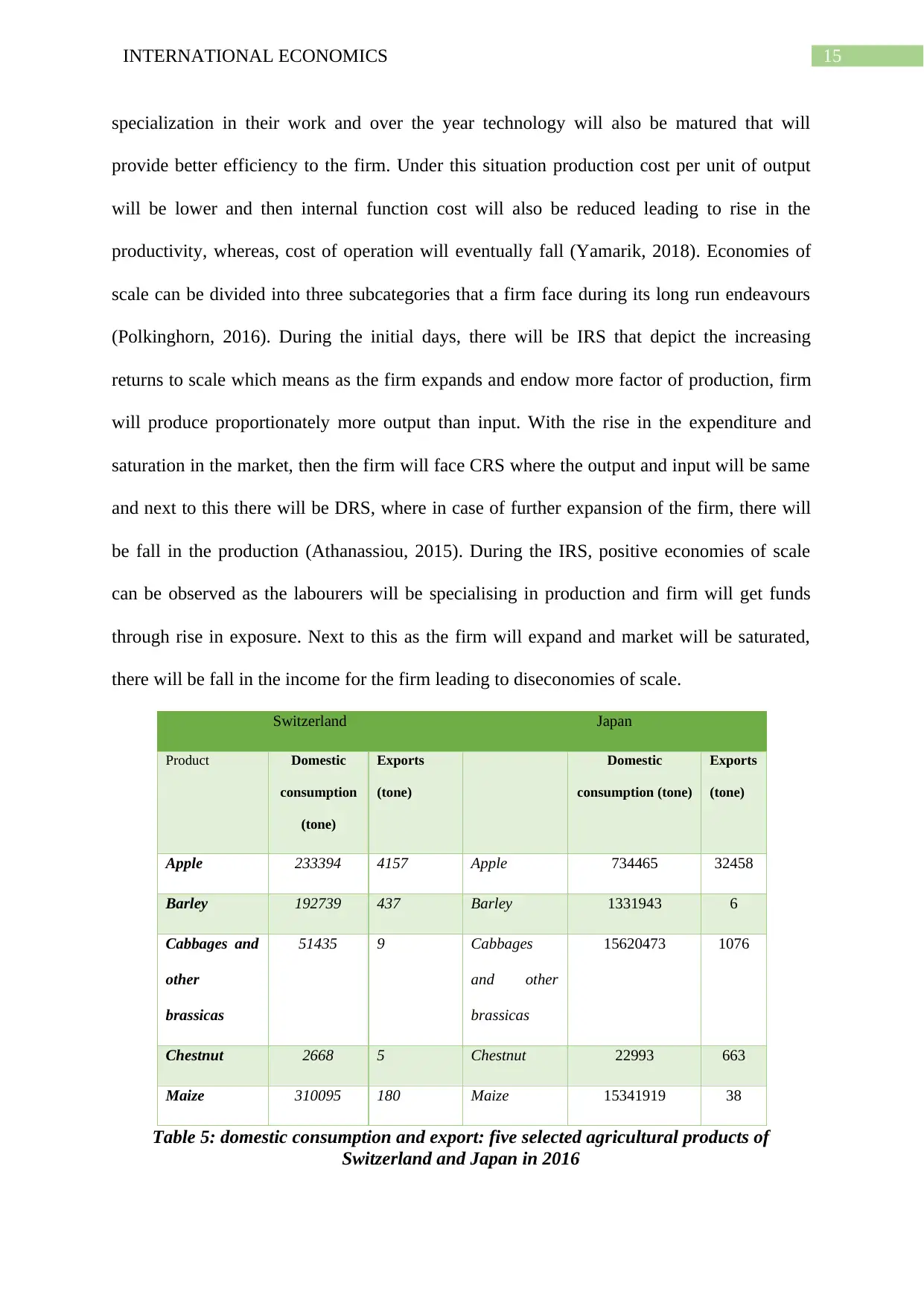
15INTERNATIONAL ECONOMICS
specialization in their work and over the year technology will also be matured that will
provide better efficiency to the firm. Under this situation production cost per unit of output
will be lower and then internal function cost will also be reduced leading to rise in the
productivity, whereas, cost of operation will eventually fall (Yamarik, 2018). Economies of
scale can be divided into three subcategories that a firm face during its long run endeavours
(Polkinghorn, 2016). During the initial days, there will be IRS that depict the increasing
returns to scale which means as the firm expands and endow more factor of production, firm
will produce proportionately more output than input. With the rise in the expenditure and
saturation in the market, then the firm will face CRS where the output and input will be same
and next to this there will be DRS, where in case of further expansion of the firm, there will
be fall in the production (Athanassiou, 2015). During the IRS, positive economies of scale
can be observed as the labourers will be specialising in production and firm will get funds
through rise in exposure. Next to this as the firm will expand and market will be saturated,
there will be fall in the income for the firm leading to diseconomies of scale.
Switzerland Japan
Product Domestic
consumption
(tone)
Exports
(tone)
Domestic
consumption (tone)
Exports
(tone)
Apple 233394 4157 Apple 734465 32458
Barley 192739 437 Barley 1331943 6
Cabbages and
other
brassicas
51435 9 Cabbages
and other
brassicas
15620473 1076
Chestnut 2668 5 Chestnut 22993 663
Maize 310095 180 Maize 15341919 38
Table 5: domestic consumption and export: five selected agricultural products of
Switzerland and Japan in 2016
specialization in their work and over the year technology will also be matured that will
provide better efficiency to the firm. Under this situation production cost per unit of output
will be lower and then internal function cost will also be reduced leading to rise in the
productivity, whereas, cost of operation will eventually fall (Yamarik, 2018). Economies of
scale can be divided into three subcategories that a firm face during its long run endeavours
(Polkinghorn, 2016). During the initial days, there will be IRS that depict the increasing
returns to scale which means as the firm expands and endow more factor of production, firm
will produce proportionately more output than input. With the rise in the expenditure and
saturation in the market, then the firm will face CRS where the output and input will be same
and next to this there will be DRS, where in case of further expansion of the firm, there will
be fall in the production (Athanassiou, 2015). During the IRS, positive economies of scale
can be observed as the labourers will be specialising in production and firm will get funds
through rise in exposure. Next to this as the firm will expand and market will be saturated,
there will be fall in the income for the firm leading to diseconomies of scale.
Switzerland Japan
Product Domestic
consumption
(tone)
Exports
(tone)
Domestic
consumption (tone)
Exports
(tone)
Apple 233394 4157 Apple 734465 32458
Barley 192739 437 Barley 1331943 6
Cabbages and
other
brassicas
51435 9 Cabbages
and other
brassicas
15620473 1076
Chestnut 2668 5 Chestnut 22993 663
Maize 310095 180 Maize 15341919 38
Table 5: domestic consumption and export: five selected agricultural products of
Switzerland and Japan in 2016
Secure Best Marks with AI Grader
Need help grading? Try our AI Grader for instant feedback on your assignments.
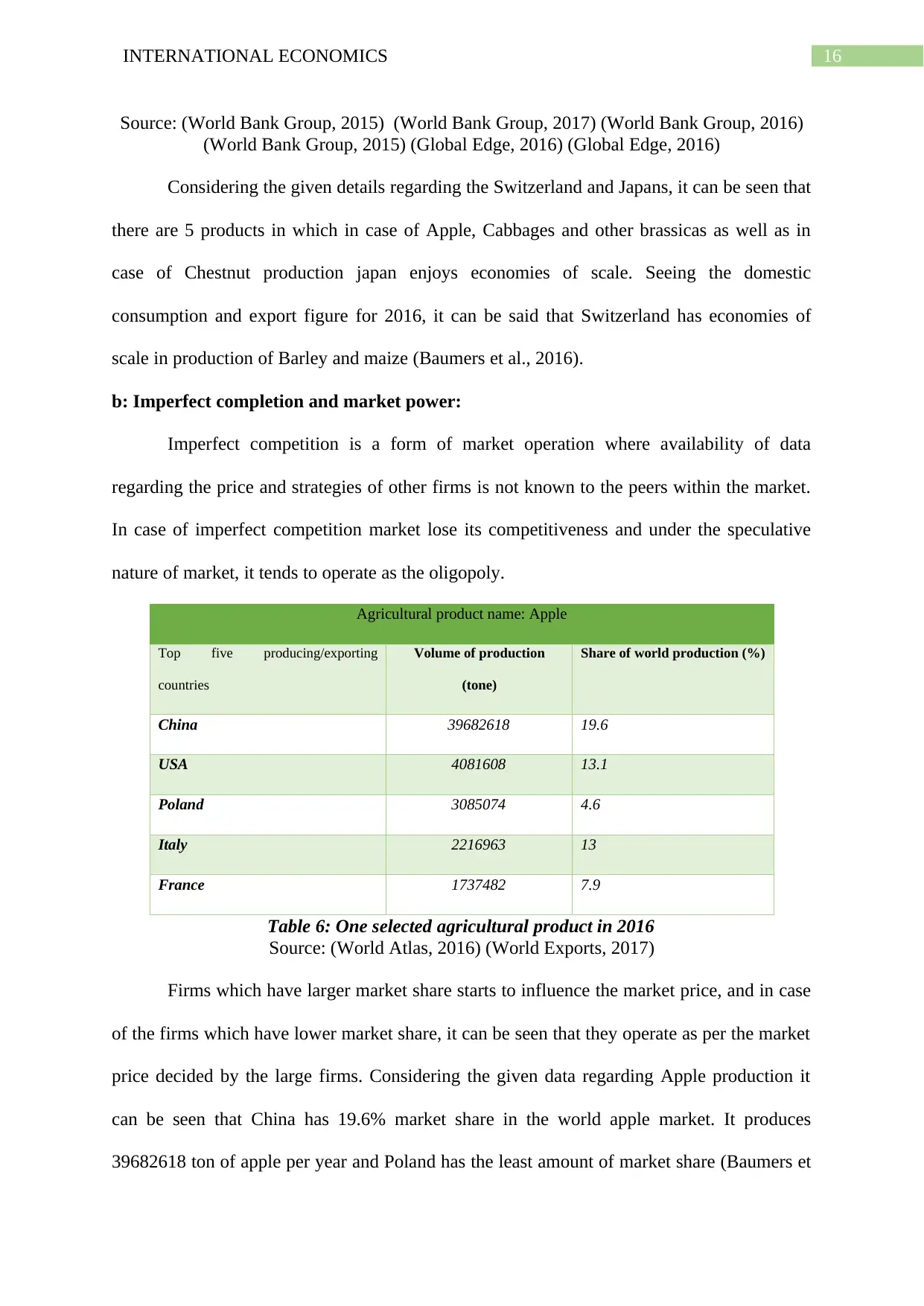
16INTERNATIONAL ECONOMICS
Source: (World Bank Group, 2015) (World Bank Group, 2017) (World Bank Group, 2016)
(World Bank Group, 2015) (Global Edge, 2016) (Global Edge, 2016)
Considering the given details regarding the Switzerland and Japans, it can be seen that
there are 5 products in which in case of Apple, Cabbages and other brassicas as well as in
case of Chestnut production japan enjoys economies of scale. Seeing the domestic
consumption and export figure for 2016, it can be said that Switzerland has economies of
scale in production of Barley and maize (Baumers et al., 2016).
b: Imperfect completion and market power:
Imperfect competition is a form of market operation where availability of data
regarding the price and strategies of other firms is not known to the peers within the market.
In case of imperfect competition market lose its competitiveness and under the speculative
nature of market, it tends to operate as the oligopoly.
Agricultural product name: Apple
Top five producing/exporting
countries
Volume of production
(tone)
Share of world production (%)
China 39682618 19.6
USA 4081608 13.1
Poland 3085074 4.6
Italy 2216963 13
France 1737482 7.9
Table 6: One selected agricultural product in 2016
Source: (World Atlas, 2016) (World Exports, 2017)
Firms which have larger market share starts to influence the market price, and in case
of the firms which have lower market share, it can be seen that they operate as per the market
price decided by the large firms. Considering the given data regarding Apple production it
can be seen that China has 19.6% market share in the world apple market. It produces
39682618 ton of apple per year and Poland has the least amount of market share (Baumers et
Source: (World Bank Group, 2015) (World Bank Group, 2017) (World Bank Group, 2016)
(World Bank Group, 2015) (Global Edge, 2016) (Global Edge, 2016)
Considering the given details regarding the Switzerland and Japans, it can be seen that
there are 5 products in which in case of Apple, Cabbages and other brassicas as well as in
case of Chestnut production japan enjoys economies of scale. Seeing the domestic
consumption and export figure for 2016, it can be said that Switzerland has economies of
scale in production of Barley and maize (Baumers et al., 2016).
b: Imperfect completion and market power:
Imperfect competition is a form of market operation where availability of data
regarding the price and strategies of other firms is not known to the peers within the market.
In case of imperfect competition market lose its competitiveness and under the speculative
nature of market, it tends to operate as the oligopoly.
Agricultural product name: Apple
Top five producing/exporting
countries
Volume of production
(tone)
Share of world production (%)
China 39682618 19.6
USA 4081608 13.1
Poland 3085074 4.6
Italy 2216963 13
France 1737482 7.9
Table 6: One selected agricultural product in 2016
Source: (World Atlas, 2016) (World Exports, 2017)
Firms which have larger market share starts to influence the market price, and in case
of the firms which have lower market share, it can be seen that they operate as per the market
price decided by the large firms. Considering the given data regarding Apple production it
can be seen that China has 19.6% market share in the world apple market. It produces
39682618 ton of apple per year and Poland has the least amount of market share (Baumers et
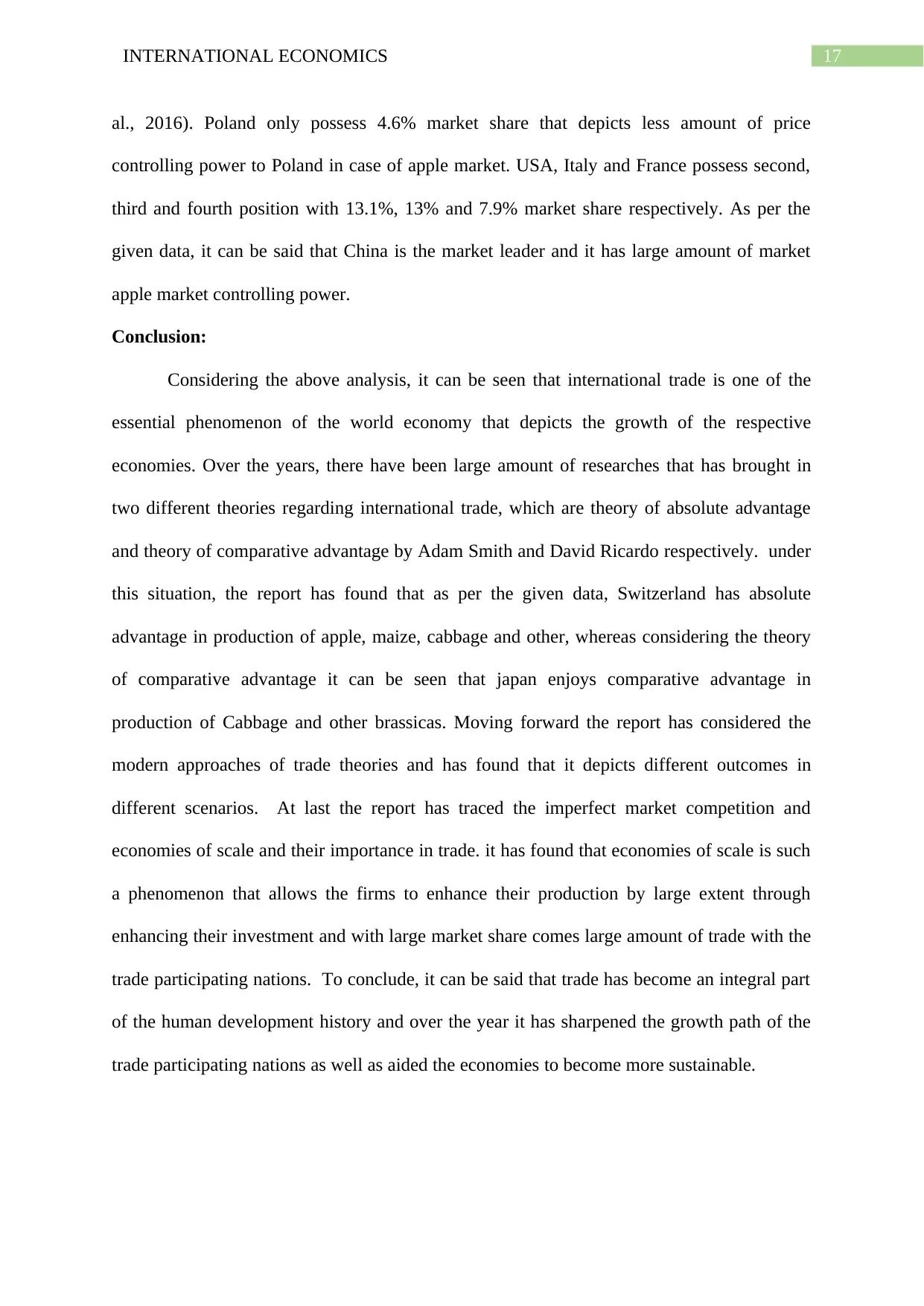
17INTERNATIONAL ECONOMICS
al., 2016). Poland only possess 4.6% market share that depicts less amount of price
controlling power to Poland in case of apple market. USA, Italy and France possess second,
third and fourth position with 13.1%, 13% and 7.9% market share respectively. As per the
given data, it can be said that China is the market leader and it has large amount of market
apple market controlling power.
Conclusion:
Considering the above analysis, it can be seen that international trade is one of the
essential phenomenon of the world economy that depicts the growth of the respective
economies. Over the years, there have been large amount of researches that has brought in
two different theories regarding international trade, which are theory of absolute advantage
and theory of comparative advantage by Adam Smith and David Ricardo respectively. under
this situation, the report has found that as per the given data, Switzerland has absolute
advantage in production of apple, maize, cabbage and other, whereas considering the theory
of comparative advantage it can be seen that japan enjoys comparative advantage in
production of Cabbage and other brassicas. Moving forward the report has considered the
modern approaches of trade theories and has found that it depicts different outcomes in
different scenarios. At last the report has traced the imperfect market competition and
economies of scale and their importance in trade. it has found that economies of scale is such
a phenomenon that allows the firms to enhance their production by large extent through
enhancing their investment and with large market share comes large amount of trade with the
trade participating nations. To conclude, it can be said that trade has become an integral part
of the human development history and over the year it has sharpened the growth path of the
trade participating nations as well as aided the economies to become more sustainable.
al., 2016). Poland only possess 4.6% market share that depicts less amount of price
controlling power to Poland in case of apple market. USA, Italy and France possess second,
third and fourth position with 13.1%, 13% and 7.9% market share respectively. As per the
given data, it can be said that China is the market leader and it has large amount of market
apple market controlling power.
Conclusion:
Considering the above analysis, it can be seen that international trade is one of the
essential phenomenon of the world economy that depicts the growth of the respective
economies. Over the years, there have been large amount of researches that has brought in
two different theories regarding international trade, which are theory of absolute advantage
and theory of comparative advantage by Adam Smith and David Ricardo respectively. under
this situation, the report has found that as per the given data, Switzerland has absolute
advantage in production of apple, maize, cabbage and other, whereas considering the theory
of comparative advantage it can be seen that japan enjoys comparative advantage in
production of Cabbage and other brassicas. Moving forward the report has considered the
modern approaches of trade theories and has found that it depicts different outcomes in
different scenarios. At last the report has traced the imperfect market competition and
economies of scale and their importance in trade. it has found that economies of scale is such
a phenomenon that allows the firms to enhance their production by large extent through
enhancing their investment and with large market share comes large amount of trade with the
trade participating nations. To conclude, it can be said that trade has become an integral part
of the human development history and over the year it has sharpened the growth path of the
trade participating nations as well as aided the economies to become more sustainable.
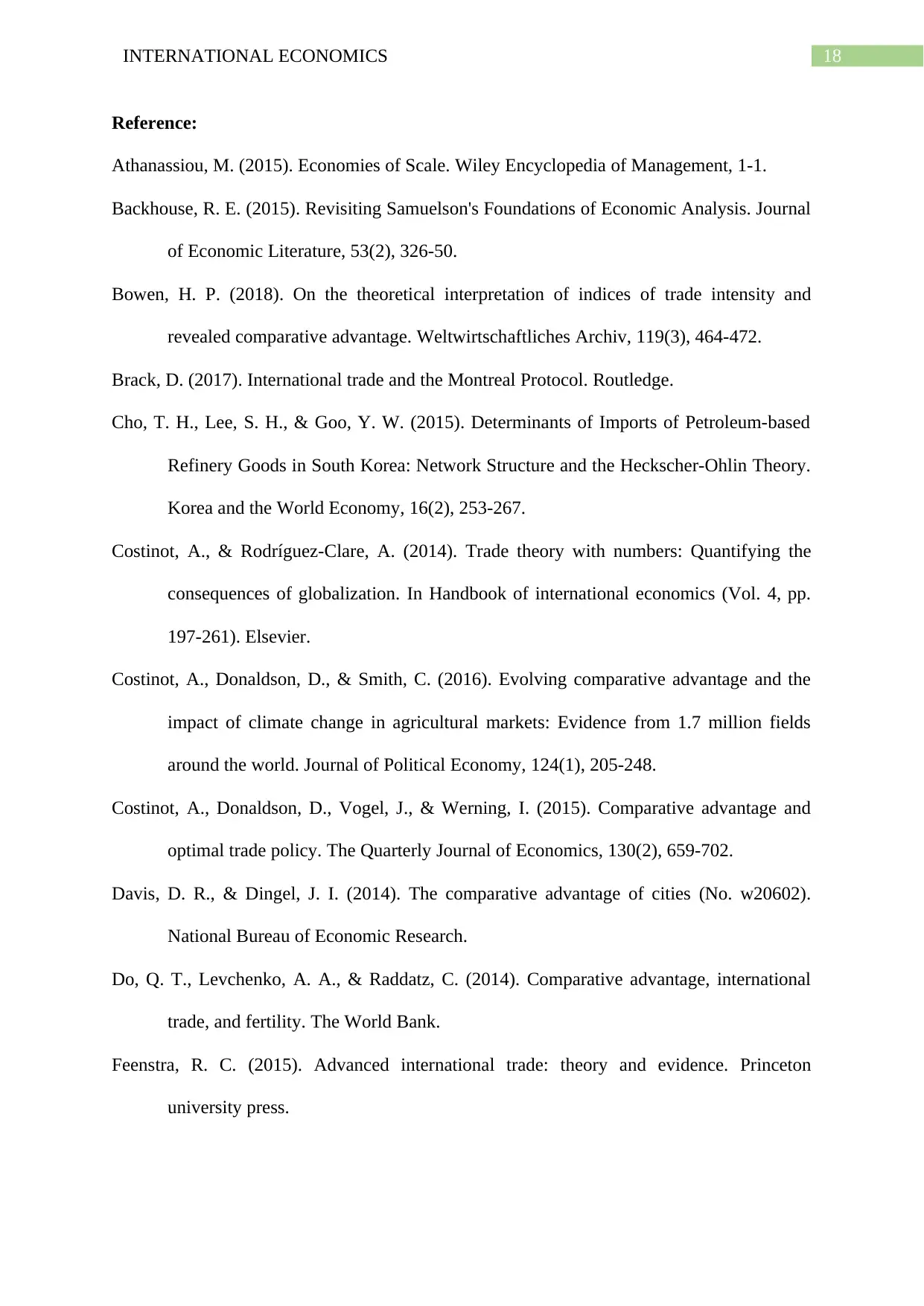
18INTERNATIONAL ECONOMICS
Reference:
Athanassiou, M. (2015). Economies of Scale. Wiley Encyclopedia of Management, 1-1.
Backhouse, R. E. (2015). Revisiting Samuelson's Foundations of Economic Analysis. Journal
of Economic Literature, 53(2), 326-50.
Bowen, H. P. (2018). On the theoretical interpretation of indices of trade intensity and
revealed comparative advantage. Weltwirtschaftliches Archiv, 119(3), 464-472.
Brack, D. (2017). International trade and the Montreal Protocol. Routledge.
Cho, T. H., Lee, S. H., & Goo, Y. W. (2015). Determinants of Imports of Petroleum-based
Refinery Goods in South Korea: Network Structure and the Heckscher-Ohlin Theory.
Korea and the World Economy, 16(2), 253-267.
Costinot, A., & Rodríguez-Clare, A. (2014). Trade theory with numbers: Quantifying the
consequences of globalization. In Handbook of international economics (Vol. 4, pp.
197-261). Elsevier.
Costinot, A., Donaldson, D., & Smith, C. (2016). Evolving comparative advantage and the
impact of climate change in agricultural markets: Evidence from 1.7 million fields
around the world. Journal of Political Economy, 124(1), 205-248.
Costinot, A., Donaldson, D., Vogel, J., & Werning, I. (2015). Comparative advantage and
optimal trade policy. The Quarterly Journal of Economics, 130(2), 659-702.
Davis, D. R., & Dingel, J. I. (2014). The comparative advantage of cities (No. w20602).
National Bureau of Economic Research.
Do, Q. T., Levchenko, A. A., & Raddatz, C. (2014). Comparative advantage, international
trade, and fertility. The World Bank.
Feenstra, R. C. (2015). Advanced international trade: theory and evidence. Princeton
university press.
Reference:
Athanassiou, M. (2015). Economies of Scale. Wiley Encyclopedia of Management, 1-1.
Backhouse, R. E. (2015). Revisiting Samuelson's Foundations of Economic Analysis. Journal
of Economic Literature, 53(2), 326-50.
Bowen, H. P. (2018). On the theoretical interpretation of indices of trade intensity and
revealed comparative advantage. Weltwirtschaftliches Archiv, 119(3), 464-472.
Brack, D. (2017). International trade and the Montreal Protocol. Routledge.
Cho, T. H., Lee, S. H., & Goo, Y. W. (2015). Determinants of Imports of Petroleum-based
Refinery Goods in South Korea: Network Structure and the Heckscher-Ohlin Theory.
Korea and the World Economy, 16(2), 253-267.
Costinot, A., & Rodríguez-Clare, A. (2014). Trade theory with numbers: Quantifying the
consequences of globalization. In Handbook of international economics (Vol. 4, pp.
197-261). Elsevier.
Costinot, A., Donaldson, D., & Smith, C. (2016). Evolving comparative advantage and the
impact of climate change in agricultural markets: Evidence from 1.7 million fields
around the world. Journal of Political Economy, 124(1), 205-248.
Costinot, A., Donaldson, D., Vogel, J., & Werning, I. (2015). Comparative advantage and
optimal trade policy. The Quarterly Journal of Economics, 130(2), 659-702.
Davis, D. R., & Dingel, J. I. (2014). The comparative advantage of cities (No. w20602).
National Bureau of Economic Research.
Do, Q. T., Levchenko, A. A., & Raddatz, C. (2014). Comparative advantage, international
trade, and fertility. The World Bank.
Feenstra, R. C. (2015). Advanced international trade: theory and evidence. Princeton
university press.
Paraphrase This Document
Need a fresh take? Get an instant paraphrase of this document with our AI Paraphraser
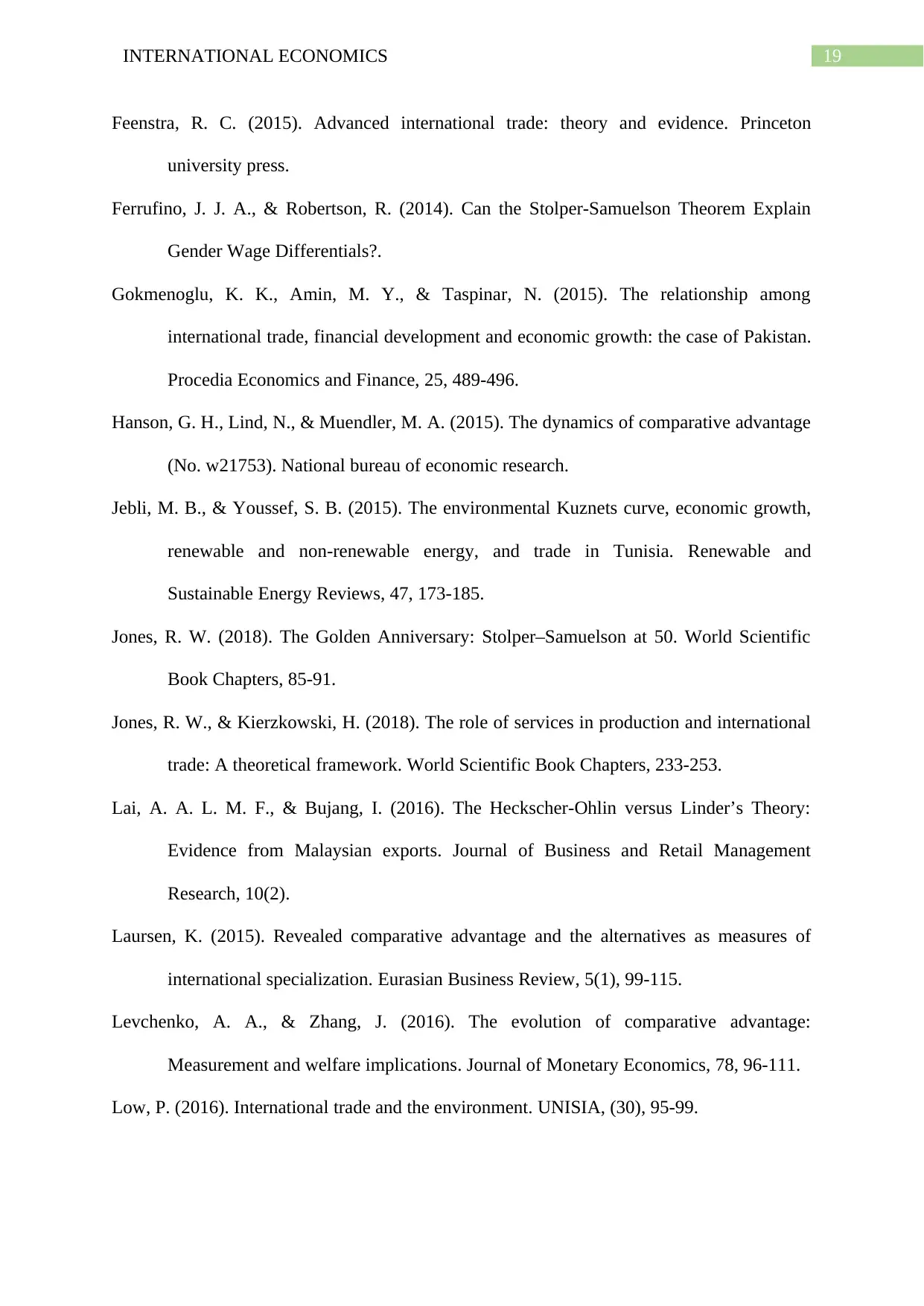
19INTERNATIONAL ECONOMICS
Feenstra, R. C. (2015). Advanced international trade: theory and evidence. Princeton
university press.
Ferrufino, J. J. A., & Robertson, R. (2014). Can the Stolper-Samuelson Theorem Explain
Gender Wage Differentials?.
Gokmenoglu, K. K., Amin, M. Y., & Taspinar, N. (2015). The relationship among
international trade, financial development and economic growth: the case of Pakistan.
Procedia Economics and Finance, 25, 489-496.
Hanson, G. H., Lind, N., & Muendler, M. A. (2015). The dynamics of comparative advantage
(No. w21753). National bureau of economic research.
Jebli, M. B., & Youssef, S. B. (2015). The environmental Kuznets curve, economic growth,
renewable and non-renewable energy, and trade in Tunisia. Renewable and
Sustainable Energy Reviews, 47, 173-185.
Jones, R. W. (2018). The Golden Anniversary: Stolper–Samuelson at 50. World Scientific
Book Chapters, 85-91.
Jones, R. W., & Kierzkowski, H. (2018). The role of services in production and international
trade: A theoretical framework. World Scientific Book Chapters, 233-253.
Lai, A. A. L. M. F., & Bujang, I. (2016). The Heckscher-Ohlin versus Linder’s Theory:
Evidence from Malaysian exports. Journal of Business and Retail Management
Research, 10(2).
Laursen, K. (2015). Revealed comparative advantage and the alternatives as measures of
international specialization. Eurasian Business Review, 5(1), 99-115.
Levchenko, A. A., & Zhang, J. (2016). The evolution of comparative advantage:
Measurement and welfare implications. Journal of Monetary Economics, 78, 96-111.
Low, P. (2016). International trade and the environment. UNISIA, (30), 95-99.
Feenstra, R. C. (2015). Advanced international trade: theory and evidence. Princeton
university press.
Ferrufino, J. J. A., & Robertson, R. (2014). Can the Stolper-Samuelson Theorem Explain
Gender Wage Differentials?.
Gokmenoglu, K. K., Amin, M. Y., & Taspinar, N. (2015). The relationship among
international trade, financial development and economic growth: the case of Pakistan.
Procedia Economics and Finance, 25, 489-496.
Hanson, G. H., Lind, N., & Muendler, M. A. (2015). The dynamics of comparative advantage
(No. w21753). National bureau of economic research.
Jebli, M. B., & Youssef, S. B. (2015). The environmental Kuznets curve, economic growth,
renewable and non-renewable energy, and trade in Tunisia. Renewable and
Sustainable Energy Reviews, 47, 173-185.
Jones, R. W. (2018). The Golden Anniversary: Stolper–Samuelson at 50. World Scientific
Book Chapters, 85-91.
Jones, R. W., & Kierzkowski, H. (2018). The role of services in production and international
trade: A theoretical framework. World Scientific Book Chapters, 233-253.
Lai, A. A. L. M. F., & Bujang, I. (2016). The Heckscher-Ohlin versus Linder’s Theory:
Evidence from Malaysian exports. Journal of Business and Retail Management
Research, 10(2).
Laursen, K. (2015). Revealed comparative advantage and the alternatives as measures of
international specialization. Eurasian Business Review, 5(1), 99-115.
Levchenko, A. A., & Zhang, J. (2016). The evolution of comparative advantage:
Measurement and welfare implications. Journal of Monetary Economics, 78, 96-111.
Low, P. (2016). International trade and the environment. UNISIA, (30), 95-99.
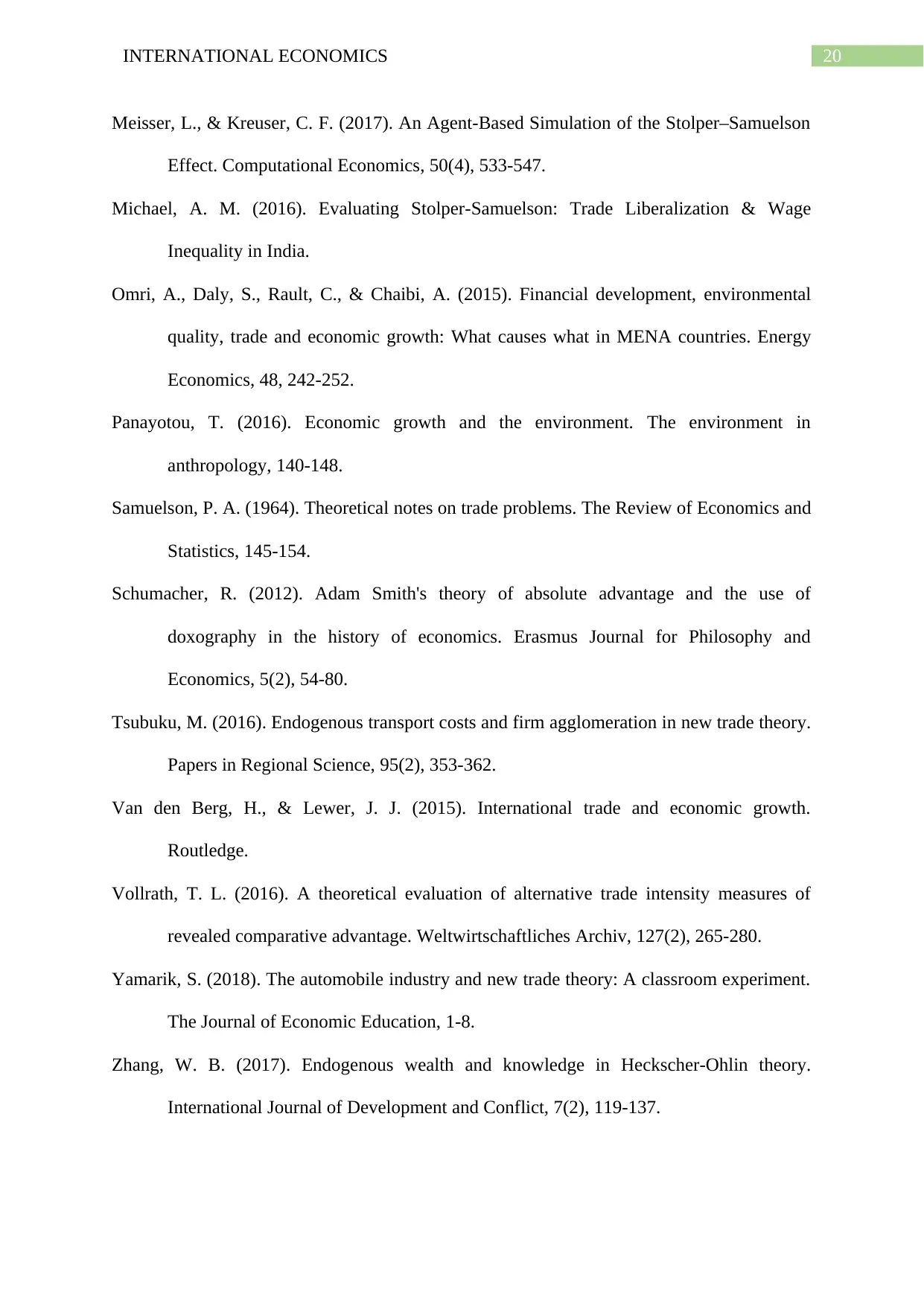
20INTERNATIONAL ECONOMICS
Meisser, L., & Kreuser, C. F. (2017). An Agent-Based Simulation of the Stolper–Samuelson
Effect. Computational Economics, 50(4), 533-547.
Michael, A. M. (2016). Evaluating Stolper-Samuelson: Trade Liberalization & Wage
Inequality in India.
Omri, A., Daly, S., Rault, C., & Chaibi, A. (2015). Financial development, environmental
quality, trade and economic growth: What causes what in MENA countries. Energy
Economics, 48, 242-252.
Panayotou, T. (2016). Economic growth and the environment. The environment in
anthropology, 140-148.
Samuelson, P. A. (1964). Theoretical notes on trade problems. The Review of Economics and
Statistics, 145-154.
Schumacher, R. (2012). Adam Smith's theory of absolute advantage and the use of
doxography in the history of economics. Erasmus Journal for Philosophy and
Economics, 5(2), 54-80.
Tsubuku, M. (2016). Endogenous transport costs and firm agglomeration in new trade theory.
Papers in Regional Science, 95(2), 353-362.
Van den Berg, H., & Lewer, J. J. (2015). International trade and economic growth.
Routledge.
Vollrath, T. L. (2016). A theoretical evaluation of alternative trade intensity measures of
revealed comparative advantage. Weltwirtschaftliches Archiv, 127(2), 265-280.
Yamarik, S. (2018). The automobile industry and new trade theory: A classroom experiment.
The Journal of Economic Education, 1-8.
Zhang, W. B. (2017). Endogenous wealth and knowledge in Heckscher-Ohlin theory.
International Journal of Development and Conflict, 7(2), 119-137.
Meisser, L., & Kreuser, C. F. (2017). An Agent-Based Simulation of the Stolper–Samuelson
Effect. Computational Economics, 50(4), 533-547.
Michael, A. M. (2016). Evaluating Stolper-Samuelson: Trade Liberalization & Wage
Inequality in India.
Omri, A., Daly, S., Rault, C., & Chaibi, A. (2015). Financial development, environmental
quality, trade and economic growth: What causes what in MENA countries. Energy
Economics, 48, 242-252.
Panayotou, T. (2016). Economic growth and the environment. The environment in
anthropology, 140-148.
Samuelson, P. A. (1964). Theoretical notes on trade problems. The Review of Economics and
Statistics, 145-154.
Schumacher, R. (2012). Adam Smith's theory of absolute advantage and the use of
doxography in the history of economics. Erasmus Journal for Philosophy and
Economics, 5(2), 54-80.
Tsubuku, M. (2016). Endogenous transport costs and firm agglomeration in new trade theory.
Papers in Regional Science, 95(2), 353-362.
Van den Berg, H., & Lewer, J. J. (2015). International trade and economic growth.
Routledge.
Vollrath, T. L. (2016). A theoretical evaluation of alternative trade intensity measures of
revealed comparative advantage. Weltwirtschaftliches Archiv, 127(2), 265-280.
Yamarik, S. (2018). The automobile industry and new trade theory: A classroom experiment.
The Journal of Economic Education, 1-8.
Zhang, W. B. (2017). Endogenous wealth and knowledge in Heckscher-Ohlin theory.
International Journal of Development and Conflict, 7(2), 119-137.
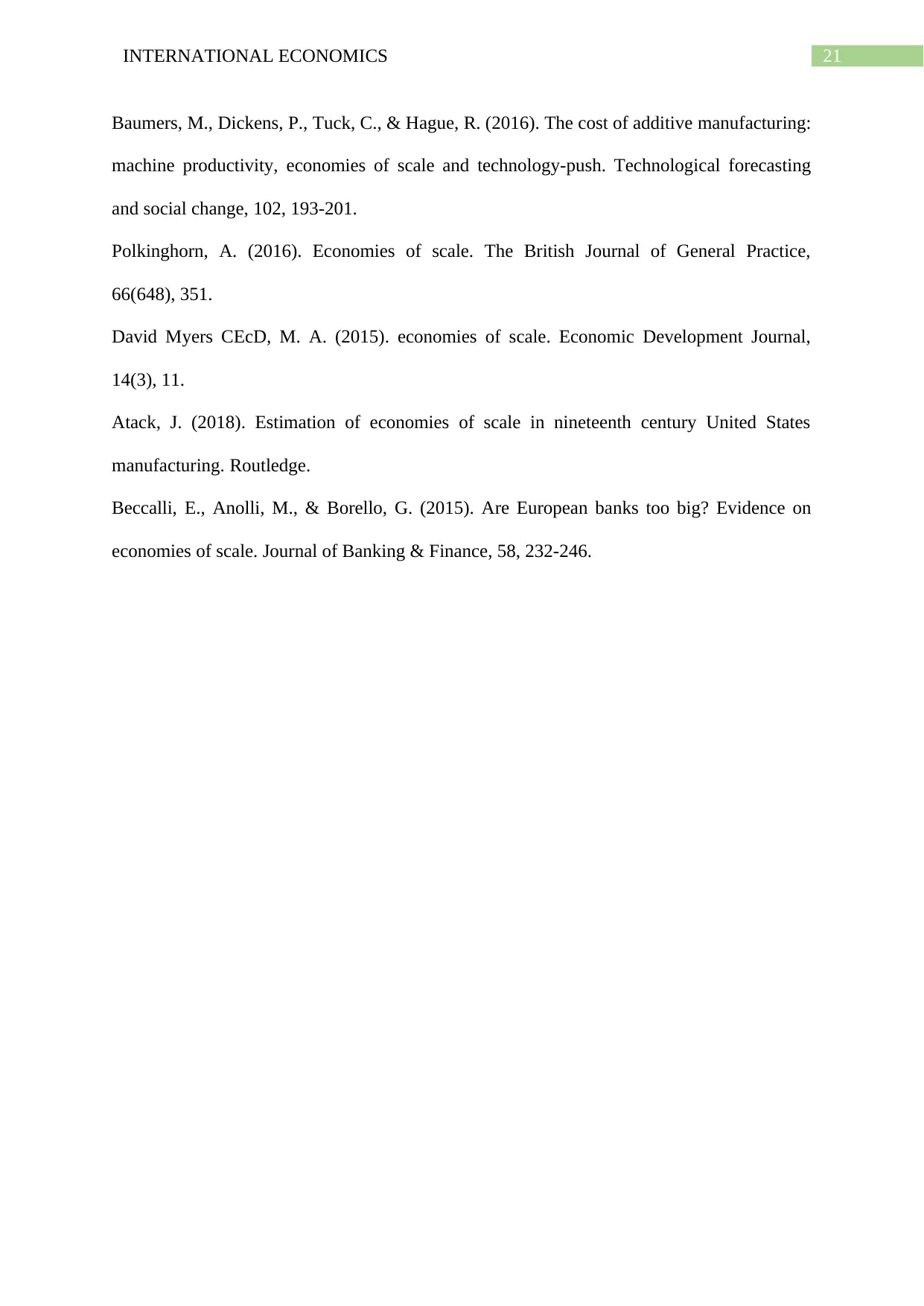
21INTERNATIONAL ECONOMICS
Baumers, M., Dickens, P., Tuck, C., & Hague, R. (2016). The cost of additive manufacturing:
machine productivity, economies of scale and technology-push. Technological forecasting
and social change, 102, 193-201.
Polkinghorn, A. (2016). Economies of scale. The British Journal of General Practice,
66(648), 351.
David Myers CEcD, M. A. (2015). economies of scale. Economic Development Journal,
14(3), 11.
Atack, J. (2018). Estimation of economies of scale in nineteenth century United States
manufacturing. Routledge.
Beccalli, E., Anolli, M., & Borello, G. (2015). Are European banks too big? Evidence on
economies of scale. Journal of Banking & Finance, 58, 232-246.
Baumers, M., Dickens, P., Tuck, C., & Hague, R. (2016). The cost of additive manufacturing:
machine productivity, economies of scale and technology-push. Technological forecasting
and social change, 102, 193-201.
Polkinghorn, A. (2016). Economies of scale. The British Journal of General Practice,
66(648), 351.
David Myers CEcD, M. A. (2015). economies of scale. Economic Development Journal,
14(3), 11.
Atack, J. (2018). Estimation of economies of scale in nineteenth century United States
manufacturing. Routledge.
Beccalli, E., Anolli, M., & Borello, G. (2015). Are European banks too big? Evidence on
economies of scale. Journal of Banking & Finance, 58, 232-246.
1 out of 22
Related Documents
Your All-in-One AI-Powered Toolkit for Academic Success.
+13062052269
info@desklib.com
Available 24*7 on WhatsApp / Email
![[object Object]](/_next/static/media/star-bottom.7253800d.svg)
Unlock your academic potential
© 2024 | Zucol Services PVT LTD | All rights reserved.





